

How Fast Do Catamarans Go? 5 Examples (With Pictures)
A catamaran is generally more balanced on the water and can be faster than a multi-hull vessel.
Unless you compare them to foiling monohulls like the new America’s Cup boats that sail at over 50 knots, they are not recreational vessels.
In this article, we will look at how fast each type of catamaran will go.
Table of Contents
Here are the numbers before we dive into the details:
| Sport Catamarans | 30 knots |
| Cruising Catamarans | 15 knots |
| Racing Catamarans | 45 knots |
| Power Cruising Catamarans | 70 knots |
| Swath Catamarans | 30 knots |
Average Speed For Sailing Catamarans
Catamarans can vary in size from 14 ft to over 100 ft. Catamarans can come in a wide variety of design types.
Sailing Catamarans have been attempting to make advancements over their mono-hulled counterparts.
These advancements include:
- Foils that assist with lifting the vessel out of the water.
- Stability advancements.
- Racers that can maintain their speed while out in the ocean.
3 Different Types of Sailing Catamarans:
1) sport catamarans.

One type of sailing catamaran is a sport catamaran, which is otherwise known as recreational. These are typically supposed to have a small crew and launch and land on beaches.
Sport catamarans do not normally have living quarters and are ideal for day trips. Resorts or other rental services often use these.
These can also be used for racing.
Sport vessels have been known to travel over 30 knots but can speed over 40 knots in the proper conditions.
2) Cruising Catamarans

Another type of sailing catamaran is a cruising catamaran. These often come with complete living accommodations, so they sacrifice speed over their sportier counterparts.
They can average between 9 and 10 knots, depending on the conditions. The top speed is typically around 15 knots.
It would be best if you were careful with catamarans that have living quarters. The more you weigh it down, the less speed you will have.
3) Racing Catamarans

The final type of sailing catamaran is an ocean racing catamaran.
These boats are large and can reach over 100 feet in length.
The top speed of this type of catamaran is around 45 knots.
Because of the prize money for entering these in races, much research goes into their advancement.
Average Speed Of Power Catamarans
Catamarans with power motors fill a different type of boating category.
These are commonly used when speed and smoothness are favored over space or capacity.
Because of their stability, catamarans are good vessels for combating seasickness as well as transportation. We have a separate article here with all you should know about catamarans and (how to overcome) seasickness .
On a commercial level, these can be used for ferries for both people and vehicles. They are used for short term travel, often to or from islands.
Like sailing catamarans, there are a few types of power catamarans.
1) Power Cruising Catamarans

Similar to sailing cruising catamarans, they also have power cruising catamarans. These also have living quarters and are stable while out on the water. The speed of these vessels highly depends on the motors equipped and the size of the boat itself.
Like passenger transport or ferries, catamarans have a high speed of about 40 to 70 miles per hour.
These are made to travel at great speeds to allow their commuters the shortest possible ride to their destination.
The military also utilizes power catamarans. They use power catamarans to transport military cargo. These ships are ideal because of their speed, holding capacity, and ability to venture into shallow ports.
2) Swath Catamarans

They also have small-waterplane-area twin-hull vessels. These are called SWATHs.
These differ from the average catamaran because they also have submarine-like hulls that stay completely under the water.
Due to the hulls being submerged, they are not normally affected by waves. These are used most often in the ocean as research vessels. They can also be used for certain types of yachts. Because of their stability, they are good vessels for furniture that will not require as much securing.
These often travel between 20 and 30 knots.
Some catamarans are designed for wave piercing. These are made to pierce through waves rather than sail over them, causing them to be faster. These can be used as passenger ferries, yachts, and military vessels as well.
3) Whitewater Catamarans

There are also recreational catamarans made for whitewater travel. These are sometimes called “cata-rafts.”
They are made using two inflatable hulls connected with a scaffold. These are lightweight and perfect for whitewater sports.
They are even able to be packed away in a backpack. They can take up to 20 minutes to assemble, including inflation.
They have high speeds on white water rivers and can be most compared to a canoe, kayak, whitewater raft, or other white water vessels.
Performance Characteristics Of Catamarans
Catamarans require four times the power to double their speed. A mono-hull vessel, however, would require eight times the power to double their speed.
This is because a Catamaran has less resistance in the water.
This is also good for conserving and using less energy.
Catamarans are also more stable in the water. This stability is effective at resisting heeling or capsizing. A multi-hull vessel would require four times the force to capsize as a similar-sized mono-hull vessel.
The general sailing in a catamaran is smoother and allows for activities that are not always possible on a mono-hull sailboat.
Are Catamarans Faster than Mono-Hull Vessels?
Because catamarans have less water resistance, they are generally faster than mono-hull vessels.
This is because their hulls are smaller, which means they have a smaller bow wave to fight.
A bow wave is a wave created by the displacement of water by the bow of a ship. After a certain speed, a boat has to start hauling itself over its own bow wave.
The larger hull a ship has, the larger its bow wave will be and the more power required to fight it.
Catamarans have two small and narrow hulls, so they do not have much of an issue with their bow wave. This is one reason they are usually faster than a similar-sized mono-hull vessel.
Catamarans can be between 20-30 percent faster than their monohull counterparts.
Issues with catamarans over mono-hulls are that they can take more time to turn.
How Is The Speed Measured?
Boats commonly measure speed using GPS tracking devices to measure distance traveled. Speed while sailing is measured in knots. A knot is one nautical mile per hour, which equals about 1.15 miles per hour.
How Fast Are Catamarans Compared To Other Boat Types?
- Sailing catamarans typically average about 10 knots.
- Pontoon boats average about 20 mph.
- A powerboat cruiser can average anywhere between 30 and 50 mph.
- Cigarette boats can even reach close to 90 mph in the proper conditions.
- Sailboats average between 6 and 12 mph depending on wind conditions. This includes mono-hull between 6 to 8 mph and catamarans and trimarans between 9 and 10mph
Two different factors can determine the speed of sailing ships:
1) The hull type as listed above.
Different hulls rest in the water more or less than other types. The less of the hull that is underwater, the faster it can go.
This is because the less of the hull in the water, the less drag created while sailing.
2) The length of the boat
The longer the boat, the faster it can go. Every boat has a maximum hull speed that cannot be exceeded unless the boat can plane on the water’s surface or be lifted on hydrofoils. For most boats, the longer the boat, the higher the maximum hull speed is.
Speed Vs. Comfort Considerations For Catamarans
If you are looking for a catamaran, you have a lot of options.
You can choose to prioritize speed or comfort.
After deciding to purchase a catamaran, the type of catamaran you should look at depends on where and what you are using it for.
You will want to make sure that you look at what type of water you will be traveling in, how many people you are traveling with on average, and what type of speed you hope to achieve.
One thing you will want to keep in mind before the purchase of a catamaran is storage. If you intend to store your boat in a marina, you are often charged for two slips due to the beam, or width, of a catamaran versus the standard mono-hull vessel.
Catamarans can be beneficial for those who get seasick because they offer a steadier ride and the ability to have more open air space. Because the living quarters are not inside the hull and under the water’s surface, you have more windows and visibility.
Both sailing and power catamarans are viable options. Also, sailing catamarans can come with back-up power engines for low winds or situations such as docking in a marina.
Catamarans that have twin engines can offer more control and precision than those on a mono-hull vessel. This is good for tight and busy areas or navigating marinas.
Overall, there are plenty of options for you, and they offer many benefits over their mono-hull counterparts.
Click to share...
- BOAT OF THE YEAR
- Newsletters
- Sailboat Reviews
- Boating Safety
- Sails and Rigging
- Maintenance
- Sailing Totem
- Sailor & Galley
- Living Aboard
- Destinations
- Gear & Electronics
- Charter Resources
- Ultimate Boating Giveaway

2022 Boat of the Year: Best Performance Catamaran
- By Cruising World Editors
- December 15, 2021
During and in the four days immediately following the US Sailboat show in Annapolis, Maryland, the Cruising World judges inspected and sailed on 27 boats vying for recognition. Learn more about the boats in our 2022 Boat of the Year »
OK, confession time. When the roster of nominees for the 2022 Boat of the Year awards was released, the contest’s team and judging panel couldn’t help themselves, and quietly put three check marks, little symbols of anticipation, alongside a trio of boats: the untamed cats that would vie for the title of best performer in their class. After all, both Balance and Seawind had entered the winner’s circle in previous BOTY competitions, and it was clear they’d have a serious contender for the throne in yet another player from cat-crazy South Africa, the Kinetic KC54. How’d it go? Let’s just say, nobody was disappointed. The conditions on Chesapeake Bay were ideal for putting the three nominees through their paces, and the trio of scalded cats all acquitted themselves superbly.
For 2022, if anything, the trend for flybridge catamarans is on a major upswing. New cats for 2022 from both Lagoon and Fountaine Pajot continued down that design path, putting an emphasis on living accommodations, not performance. But not aboard the latest Seawind 1600 , a brand originally built in Australia that is now produced in Vietnam. And that suits judge Tim Murphy just fine. “This boat was very dialed in,” he said, “and one place Seawind has always been innovative is with their helms. This one was really great; it was -outboard and aft with great visibility, sort of half-protected where you could step in and out. There was also good access to the boom and mainsail, which you don’t always see on cats. The deck layout was excellent, particularly the forward trampolines. Some cats have lacings with large openings where you can twist an ankle, but these were nice and tight.”
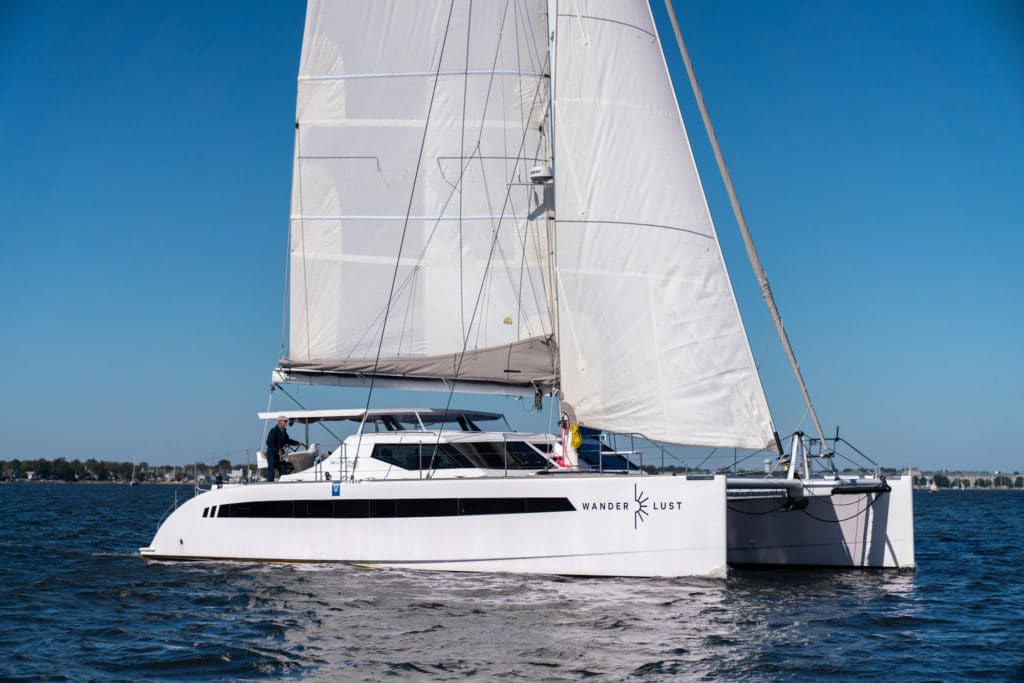
“Compared to other Seawinds that I’ve seen, I was just blown away with it in terms of what it could do and how it performed,” said Ed Sherman. “It’s a fairly conservative boat in terms of technology compared to some of the other boats in the same category, which depending on a potential buyer’s state of mind, could be either a good thing or a bad one. I loved the centralized winch aft which is where all the sail-handling takes place. It’s pretty brilliant for a short-handed crew, and it’s all in a very safe and easy-to-access location that a cruising couple can deal with without scaring the heck out of themselves.”
The Kinetic KC54 is a fresh entry in the cat universe, and we’ll let Tim Murphy get right to the point: “This is a fairly new company that was started within the past couple of years. My breath was absolutely taken away by this boat; it was spectacular. I think it was the best-built boat in the entire fleet. It’s an all-carbon boat, with a foam core, epoxy resin, all infused–fantastic. The whole boat felt integrated. You didn’t feel like there was a conflict between the forces in terms of accommodation versus performance.” With a price tag approaching $3 million, it perhaps should not be astonishing. That was a major factor in evaluating the boat, and while it did not win its class, the experts panel did present it with a Judges’ Special Recognition prize to honor the boat’s overall excellence.
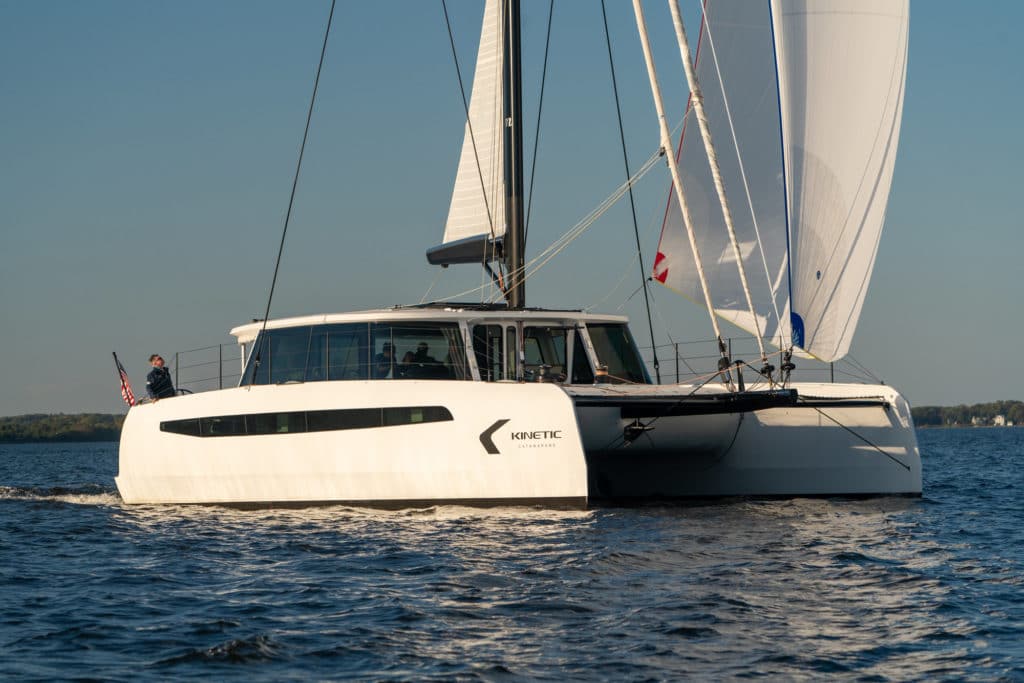
“It was my personal favorite in this year’s contest,” said Sherman. The materials that were used are absolutely the highest quality available in our industry at this point, and it’s a very high-tech boat in terms of systems.” Gerry Douglas was also duly impressed: “This was the Tesla of sailboats. I think that that was their model. In terms of design and execution and technology, it hit all three of those marks. This boat is built without compromise, and what it cost was not an issue, they just wanted to do the best they could in every aspect of the boat. The construction was impeccable, the fit and finish was amazing. There are some very clever design things in the boat, but it all really worked seamlessly.”
With that level of competition, the Balance 482 had a tall order to overcome to win its class. And it did. “The sailing performance was excellent,” said Douglas. “The boat felt really good. The steering was terrific. The structure of the boat throughout was exemplary. Storage is really good. Visibility was good. Ventilation was great. There was even a rain collection system on the cabin top, which is the only one of the boats we looked at had that. It was very well concealed because the gutters formed a handhold going forward. The solar panel installation was also well done. The panels were encapsulated into a fiberglass tray that elevated the deck so the panels wouldn’t overheat. Very clever.”
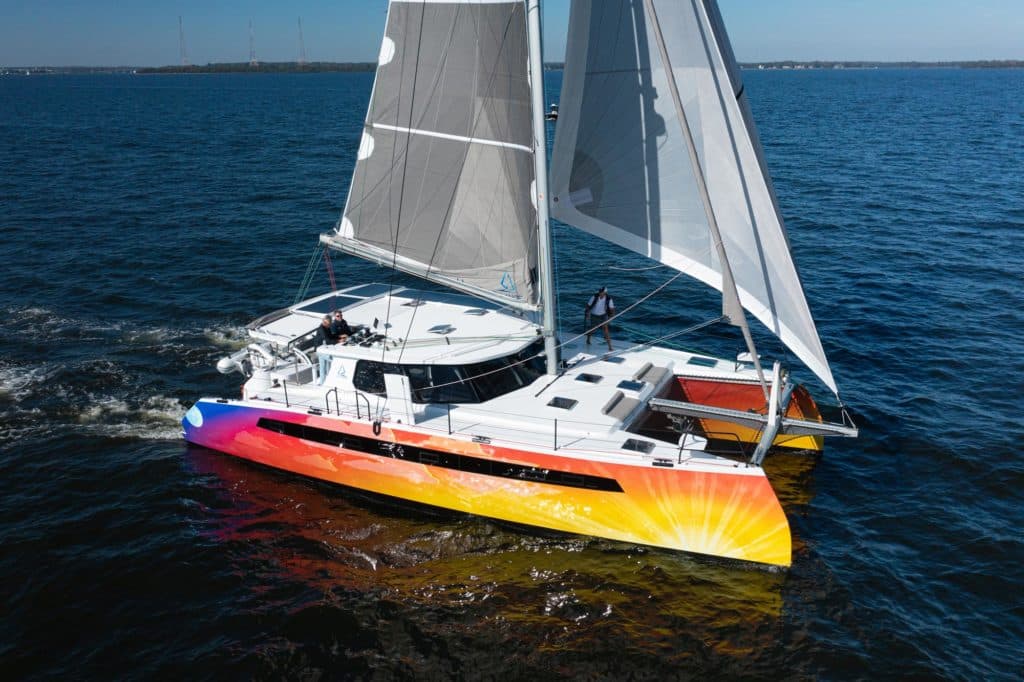
The driving force behind Balance cats is Phil Berman, a world champ at racing beach cats who brought that passion to developing and marketing fully found cruisers. Judge Murphy knows him well: “Phil comes from a very strong view of wanting to see boats that have solid sailing performance. He’s also a strong proponent of daggerboard boats, which tends to be quick shorthand for the dividing line between cats that are more about payload versus cats that are about performance, but not so much where you’re going to fly a hull or break a rudder. There’s a balance within a boat that really performs that you can still live aboard.” A winning balance, it turns out, with the Balance 482 securing its position as the Best Performance Cruiser for 2022.
- More: balance catamarans , Boat of the Year , Boat of the Year 2022 , catamaran , Kinetic Catamarans , print 2022 jan , Sailboats , seawind catamarans
- More Sailboats

Pre-Owned: 1988 Hylas 47

Catalina Introduces the 6 Series

Sailboat Preview: Elan GT6 Explorer

For Sale: 1984 Camper & Nicholsons 58
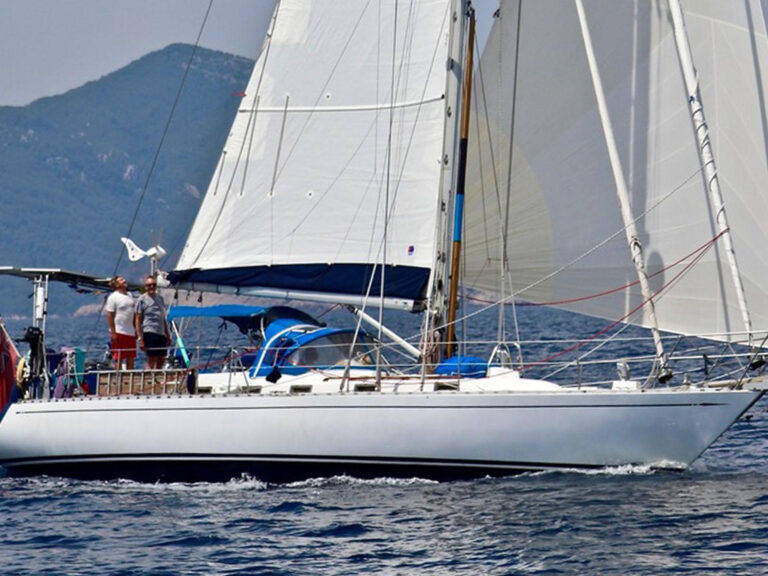
Understanding Wind in the West Indies
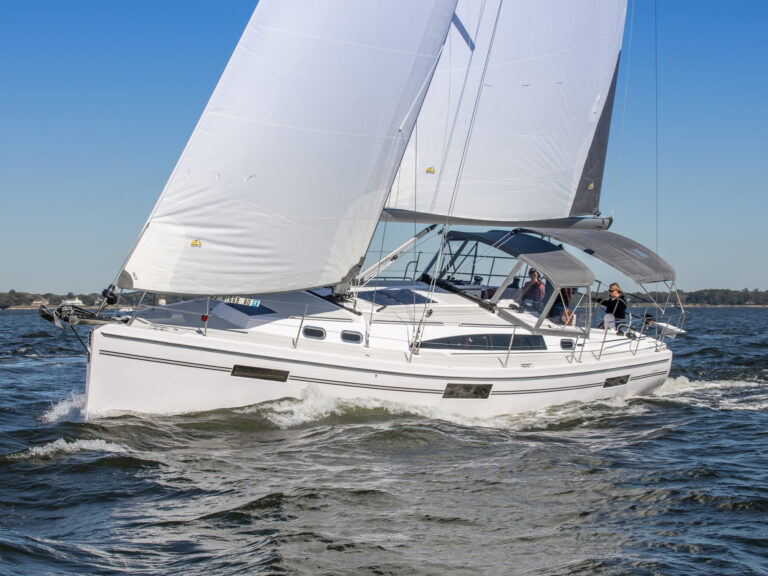
At Your Service
- Digital Edition
- Customer Service
- Privacy Policy
- Terms of Use
- Email Newsletters
- Cruising World
- Sailing World
- Salt Water Sportsman
- Sport Fishing
- Wakeboarding

My Cruiser Life Magazine
Sailing Catamaran Speed
You’ve probably heard that one of the best reasons to get a catamaran is because they’re fast. After all, there’s a race any time there are two sailboats on the same waterway.
But like all things in boating, speed is a relative term. Catamarans seem fast to those coming from slow and heavy monohull sailboats, but cruising catamarans are still pretty slow vessels. There are indeed high-tech racing catamarans breaking speed records all the time. Still, the vessels that most liveaboard cruisers venture out on are only slightly faster than their monohull counterparts.
For this article, we will look at the types of catamarans people live on and cruise on. Forget about those fantastic America’s Cup yachts or those multihull go-fast fishing boats for a few minutes.
I have had experience cruising and living aboard both catamarans and monohulls. For five years, my wife and I enjoyed catamaran sailing on a Lagoon 380. We then switched—for many reasons—to a Cabo Rico 38. The Cabo Rico is a traditionally-designed monohull with a full keel and a heavy displacement. In other words, it’s about as far away from a “speedy” catamaran as one can get.
Table of Contents
How fast can a catamaran go, measuring catamaran speed, catamaran speeds vs monohull speeds, sailing cruising catamarans, performance cruising catamarans, racing catamarans, power cruising catamarans, catamaran top speed, faqs – how fast are catamarans.
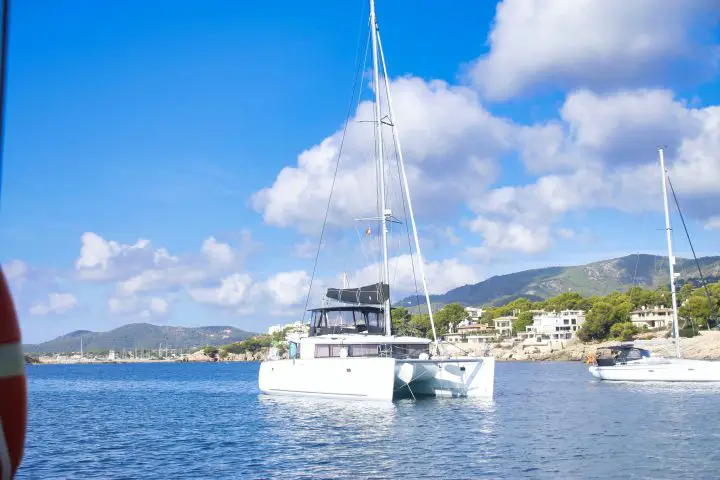
There’s no doubt that catamarans are some of the fastest sailboats around—but there’s also a lot of misinformation and misunderstanding online about how fast they really are.
Realize that not all catamarans are created equally. There are cruising catamarans built to carry their passengers in comfort. And then there are racing catamarans built for nothing but speed. Somewhere in between, there is a poorly-defined category of “performance cruising” catamarans that stir passions.
So, are catamarans fast? Well, it’s all relative. But, if you compare them to monohull sailboats of similar sizes and capabilities, the catamarans are usually faster for several reasons.
The speed difference is even harder to measure in the cruising catamaran category. One of the reasons catamarans beat monohulls during races is because they are built light with no ballast. But a heavily-laden cruising cat ready for an ocean crossing is hardly “lightly loaded.” Will it still beat a similarly heavily-laden monohull? Sure! But probably not by as much as you might think.
Boats measure their speed in knots. Traditionally, this was measured by a tool known as a knot log. The modern equivalent is an underwater instrument with a spinning wheel that effectively measures the speed of the water passing over the hull. So long as no currents are present, that speed will equal the boat’s speed over the ground (SOG).
Satellite navigation allows us to measure our SOG more accurately, but this isn’t a great indication of boat performance since it will be affected by tides and ocean currents.
For landlubbers, one knot is equal to about 1.15 statute miles. So, in other words, when we say that a sailboat cruises at 6 knots, it means it’s going about 7 mph.
But before going any further, consider this—the maximum speed that a sailboat makes is generally a pretty meaningless number. Maybe the knot log pegs to 13 knots for a few seconds, thanks to a strong gust of wind while you’re headed down a large swell. Does this mean you’re driving a 13-knot boat?
A voyaging sailor who has made a long passage will have little interest in this sort of number. When you’re crossing oceans, what really matters is how many miles pass under the keel each day. The more miles you tick off, the shorter the passage. So most sailors learn quickly to look past the “fastest speed in knots” number and find real-world stats on passage miles.
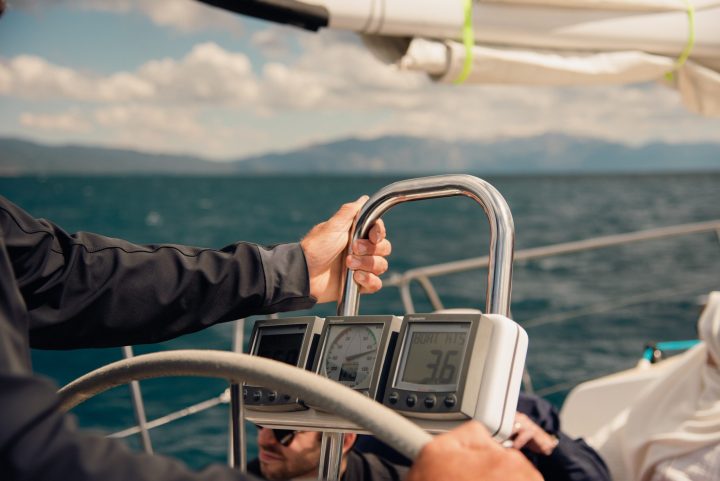
Comparing speeds between radically different sailing vessel hulls is like comparing apples to oranges. Even seemingly similar boats, like “cruising sailboats,” the differences between one and the other are endless.
For example, let’s say you wanted to compare 38-foot monohulls to 38-foot catamarans. The speed of a monohull is limited by waterline length, which means you’d have to look at a hull that is significantly more than 38 feet in most cases. On the other hand, the catamaran is known for long swim platforms on inverse transoms and plumb bows—meaning most 38 foot cats have nearly 38 feet of waterline.
Then, what sort of hull design makes a fair comparison to a catamaran? Would it make sense to compare a transitional, salty 38-footer with a full keel? Probably not. Most sailors interested in the cruising catamaran lifestyle would more than likely be comparing it to a modern monohull with a flatter bottom, fin keel, and spade rudder.
What about the catamaran? There’s a lot of variation in the catamaran field regarding performance. If speed is your goal, you likely want to compare the high-end performance brands—Outremer, Gunboat, HH, and the like. These boats are becoming more popular, but most cruising cats you see on the water are not performance models. Instead, they are the big and comfortable cruisers made by Lagoon, Leopard, or Fountaine Pajot.
Finally, how can you fairly compare the stats? Boats sail differently in different wind speeds and at different points of sail. In other words—there are a lot of variables that make it hard to answer the question, “How fast can a catamaran go?”
Polar charts for each vessel can provide some clues to make a somewhat fair comparison. Polar charts are graphical plots of a sailboat’s performance in different wind conditions and at different points of sail. Manufacturers seldom publish since no two are ever perfectly alike. They are less of a boat specification and more of one sailor’s results for a particular boat. Most owners make their own polar diagrams, but they’re still a tool for those looking to get an idea of a model’s performance in the real world.
Speeds of Various Types of Sailing Catamarans
There are several distinct catamaran classes, and predicting speed means understanding what the designers were building the craft to do. You might be surprised to learn that the first “modern” catamarans popped up in the New England racing circles in the late 1800s. Nat Herreshoff’s Amaryllis is particularly famous from the time .
Since then, catamarans have been synonymous with speed. But in today’s world of many different multihull designs, it’s important to set your expectations accordingly. As you would not buy a Ferrari for its cargo space, don’t expect your minivan to win any races at the track.
Examples of cruising cats include popular models made by the big-three catamaran makers—Lagoon, Fountaine Pajot, and Leopard. However, there are dozens of other companies making these boats. The market and industry for cruising catamarans have never been larger.
Most of these boats are engineered to provide comfortable accommodations for voyaging. They first became famous as vessels for sail charter holidays, where their huge cockpits and private cabins made them much more popular than the smaller and cramped monohull options.
As a result, they’re not built with high-tech components or super lightweight performance rigs. Instead, they’re the catamaran equivalent of a Hunter or a Catalina sailboat—mass-produced on an assembly line. That keeps prices lower than other types of catamarans, but it also means that they’re not winning any races. The makers use traditional layups with end-grain balsa-cored fiberglass to keep costs down. In addition, they usually feature stub fin keels, which are foolproof to sail but will not provide the upwind performance of a lift-making daggerboard.
Still, without ballast and when lightly loaded, cruising catamarans can move. They show their colors in light air when heavy displacement-hulled sailboats usually make their poorest showing. Since these moderate conditions also make for great cruising, these boats can provide a lovely ride in smooth weather.
Cruising catamarans can’t plane or anything, but their narrow hulls create an effect that means they can beat the hull speeds of a similarly sized monohull. Of course, it’s not a precise number since every boat and crew is different, but generally, you could expect speeds to be about one and a half times that of a same-sized monohull.
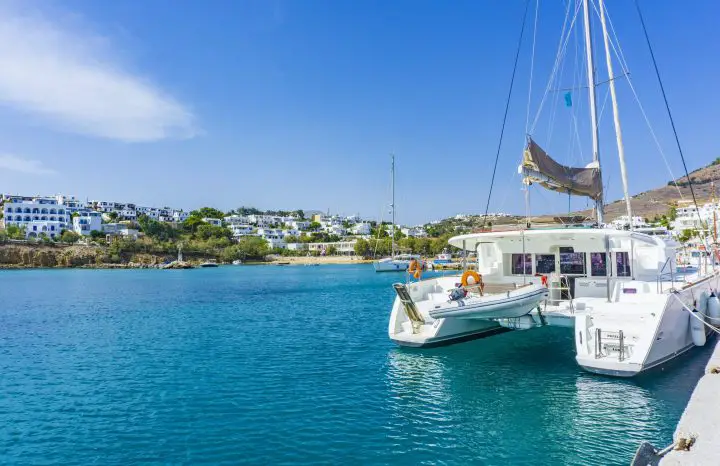
These catamarans are still rigged for comfort, but they’re built using the highest-quality and lightest-weight materials. While their hulls are rigged for comfortable living, they are generally designed much sleeker than regular charter-style cruising catamarans. The hulls are narrower, and you’re unlikely to see tall flybridges or forward lounge seating.
Several companies are making these boats. But in the world of catamarans, a performance cruiser is the upper end of the market. If you want a car comparison, Lagoons are something like a Chevy sedan, whereas an Outremer is like an M-series BMW. A Gunboat would be even more exotic, like a Ferrari. Not only are they more fashionable brands, but they’re also made to higher standards with cutting-edge designs .
It’s also worth noting that the category of “performance cruising cat” is a sliding scale. Some companies make vessels with better materials and craftsmanship than the cruising cats but aren’t designed for speed. Others build cats that are all about performance with few amenities.
With every new model, companies building these cutting-edge boats are attempting to boost the “performance” and the “cruising” aspect of their vessels. As a result, amenities and speed continue to get better and better.
Any racing sailboat is not designed for comfort. Especially on a catamaran, accommodations take up space and weigh the boat down. True racing vessels are designed to not worry about the crew but optimize every element for speed. Once the boat is designed for the desired performance, they’ll squeeze in bunks and storage wherever they can.
As such, there’s not much point in comparing them to liveaboard or cruising sailing vessels—they are too different. Some modern racing catamarans even fly above the water on foils. This makes for a high-speed boat and a considerable risk for sailors traveling for pleasure. Gunboat tried to make a foiling cruising cat in the G4 model, but it didn’t go so well for them.
Power cats run the same gamut of designs that sailing catamarans do. Power catamarans and sport catamarans designs are popular in powerboat circles for the same reasons they are in the sailing world–their hull designs allow for smaller underwater profiles and high speeds. There are many fast catamarans out there with twin engines and average speeds of well over 70 knots. Most recreational vessels cruise at about 20 knots, however.
Power catamarans also offer a smooth ride, making them a popular choice for large vessels like passenger ferries. There are even military vessels that use two hulls, like the stealth M80 Stiletto .
As you can see, catamaran speeds vary from just slightly better than monohulls to extraordinary flying machines. But cats are about much more than just speed. Their open and bright living space makes living aboard an entirely different experience than living on a monohull. Their cockpits flow into their salons for a full-time outdoor living feel that no other type of vessel can match. There are many reasons to choose a catamaran as a liveaboard sailboat.
How fast is a catamaran?
The answer depends on many other questions, like what sort of catamaran is it? And if it’s a sail cat, how fast is the wind blowing?
Sailing catamarans come in all different shapes and sizes. Some are optimized for living space and comfort, while others are designed with fast cruising speeds being the sole goal of the boat. The Gunboat 68, one of the fastest cruising sailboats currently made, can exceed 30 knots.
The world of power cats is much the same. Some power cats can do well over 70 knots, while most cruising boats top out at around 20 knots.
Do catamarans have a hull speed?
A hull speed is a characteristic of traditional displacement-hulled sailing vessels. The properties of the hull shape under the water create drag that limits the overall speed that the vessel can achieve. Even if you keep adding more power (or more wind), the vessel cannot exceed its designed hull speed for any length of time. Hull speed is a factor of waterline length.
Multihulls, however, have an entirely different underwater profile than monohulls. Their narrow hulls and shallow keels mean that drag is not the limiting factor. With this in mind, designers can tweak catamaran hulls to plane and cruise well above the hull speed of a similarly sized monohull.
What is the fastest cruising catamaran?
The market for fast-moving cruising cats has never seen more innovation than in the past decade. This type of boat has taken off, spurred in part by new designs and the overall popularity of multihulls for cruising. The industry leader in fast multihulls is generally considered the French-based company Gunboat . After all, one of the company’s mottos is “Life is too short to sail a slow boat.”
The company’s largest boat to date is the Gunboat 90 Sunshine . However, the delivery of the company’s current flagship, the Gunboat 68 Condor , from France to St. Maarten, provides some real-world numbers. In the delivery crew’s words, “Our max speed exceeded 30 knots a couple of times, and the max 24-hour run was 328 nm.” To save you the math, that works out for an average speed of 13.7 knots for their best day.
Matt has been boating around Florida for over 25 years in everything from small powerboats to large cruising catamarans. He currently lives aboard a 38-foot Cabo Rico sailboat with his wife Lucy and adventure dog Chelsea. Together, they cruise between winters in The Bahamas and summers in the Chesapeake Bay.
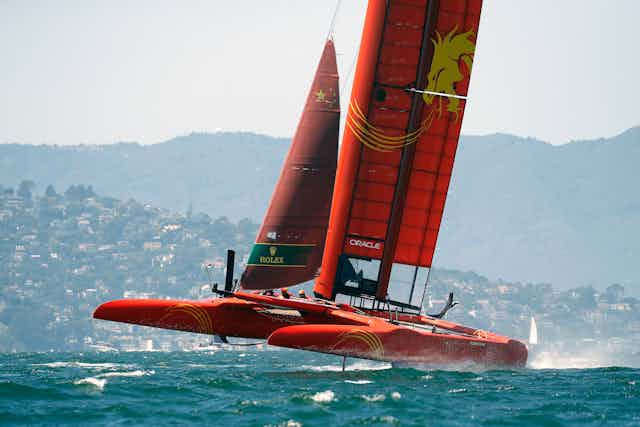
Sail GP: how do supercharged racing yachts go so fast? An engineer explains
Head of Engineering, Warsash School of Maritime Science and Engineering, Solent University
Disclosure statement
Jonathan Ridley does not work for, consult, own shares in or receive funding from any company or organisation that would benefit from this article, and has disclosed no relevant affiliations beyond their academic appointment.
View all partners
Sailing used to be considered as a rather sedate pastime. But in the past few years, the world of yacht racing has been revolutionised by the arrival of hydrofoil-supported catamarans, known as “foilers”. These vessels, more akin to high-performance aircraft than yachts, combine the laws of aerodynamics and hydrodynamics to create vessels capable of speeds of up to 50 knots, which is far faster than the wind propelling them.
An F50 catamaran preparing for the Sail GP series recently even broke this barrier, reaching an incredible speed of 50.22 knots (57.8mph) purely powered by the wind. This was achieved in a wind of just 19.3 knots (22.2mph). F50s are 15-metre-long, 8.8-metre-wide hydrofoil catamarans propelled by rigid sails and capable of such astounding speeds that Sail GP has been called the “ Formula One of sailing ”. How are these yachts able to go so fast? The answer lies in some simple fluid dynamics.
As a vessel’s hull moves through the water, there are two primary physical mechanisms that create drag and slow the vessel down. To build a faster boat you have to find ways to overcome the drag force.
The first mechanism is friction. As the water flows past the hull, a microscopic layer of water is effectively attached to the hull and is pulled along with the yacht. A second layer of water then attaches to the first layer, and the sliding or shearing between them creates friction.
On the outside of this is a third layer, which slides over the inner layers creating more friction, and so on. Together, these layers are known as the boundary layer – and it’s the shearing of the boundary layer’s molecules against each other that creates frictional drag.
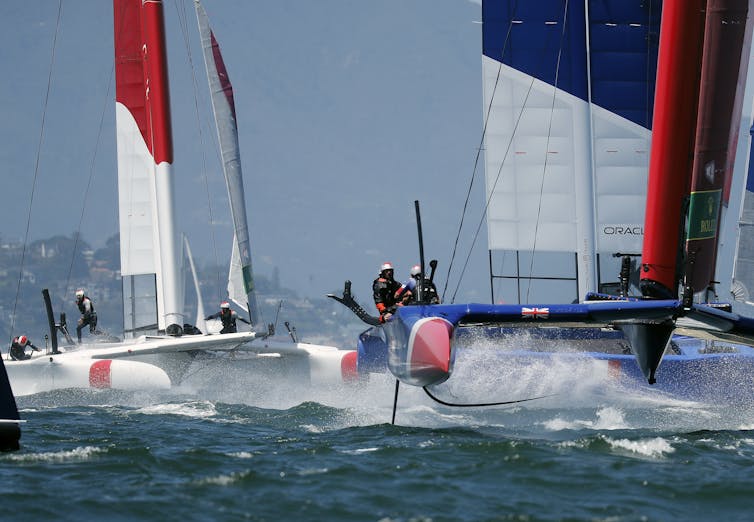
A yacht also makes waves as it pushes the water around and under the hull from the bow (front) to the stern (back) of the boat. The waves form two distinctive patterns around the yacht (one at each end), known as Kelvin Wave patterns.
These waves, which move at the same speed as the yacht, are very energetic. This creates drag on the boat known as the wave-making drag, which is responsible for around 90% of the total drag. As the yacht accelerates to faster speeds (close to the “hull speed”, explained later), these waves get higher and longer.
These two effects combine to produce a phenomenon known as “ hull speed ”, which is the fastest the boat can travel – and in conventional single-hull yachts it is very slow. A single-hull yacht of the same size as the F50 has a hull speed of around 12 mph.
However, it’s possible to reduce both the frictional and wave-making drag and overcome this hull-speed limit by building a yacht with hydrofoils . Hydrofoils are small, underwater wings. These act in the same way as an aircraft wing, creating a lift force which acts against gravity, lifting our yacht upwards so that the hull is clear of the water.

While an aircraft’s wings are very large, the high density of water compared to air means that we only need very small hydrofoils to produce a lot of the important lift force. A hydrofoil just the size of three A3 sheets of paper, when moving at just 10 mph, can produce enough lift to pick up a large person.
This significantly reduces the surface area and the volume of the boat that is underwater, which cuts the frictional drag and the wave-making drag, respectively. The combined effect is a reduction in the overall drag to a fraction of its original amount, so that the yacht is capable of sailing much faster than it could without hydrofoils.
The other innovation that helps boost the speed of racing yachts is the use of rigid sails . The power available from traditional sails to drive the boat forward is relatively small, limited by the fact that the sail’s forces have to act in equilibrium with a range of other forces, and that fabric sails do not make an ideal shape for creating power. Rigid sails, which are very similar in design to an aircraft wing, form a much more efficient shape than traditional sails, effectively giving the yacht a larger engine and more power.
As the yacht accelerates from the driving force of these sails, it experiences what is known as “ apparent wind ”. Imagine a completely calm day, with no wind. As you walk, you experience a breeze in your face at the same speed that you are walking. If there was a wind blowing too, you would feel a mixture of the real (or “true” wind) and the breeze you have generated.
The two together form the apparent wind, which can be faster than the true wind. If there is enough true wind combined with this apparent wind, then significant force and power can be generated from the sail to propel the yacht, so it can easily sail faster than the wind speed itself.
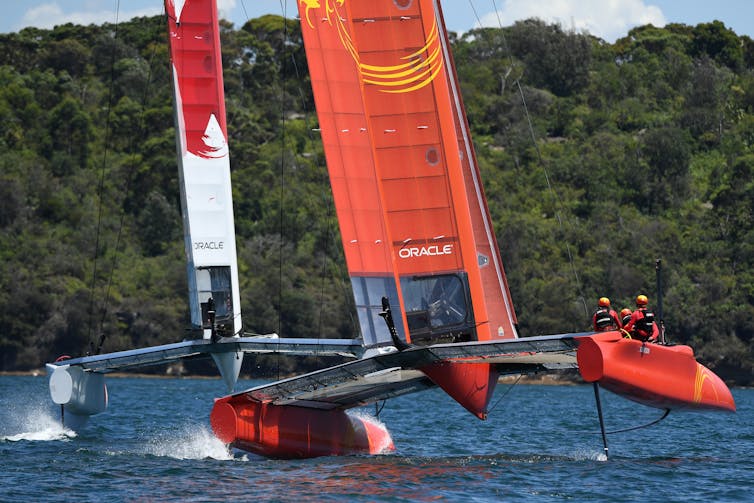
The combined effect of reducing the drag and increasing the driving power results in a yacht that is far faster than those of even a few years ago. But all of this would not be possible without one further advance: materials. In order to be able to “fly”, the yacht must have a low mass, and the hydrofoil itself must be very strong. To achieve the required mass, strength and rigidity using traditional boat-building materials such as wood or aluminium would be very difficult.
This is where modern advanced composite materials such as carbon fibre come in. Production techniques optimising weight, rigidity and strength allow the production of structures that are strong and light enough to produce incredible yachts like the F50.
The engineers who design these high-performance boats (known as naval architects ) are always looking to use new materials and science to get an optimum design. In theory, the F50 should be able to go even faster.
- Engineering
- Aerodynamics

Research Fellow Community & Consumer Engaged Health Professions Education

Professor of Indigenous Cultural and Creative Industries (Identified)

Communications Director

University Relations Manager

2024 Vice-Chancellor's Research Fellowships

12 Best Catamaran Sailboats

The appeal of the catamaran sailboats in terms of speed , stability, and the ability to embark on long-range cruising has made them hugely popular with today's sailors. But what are the best catamaran sailboats?
Even though catamaran sailboats have become increasingly popular in the last few years, they have a truly rich legacy as one of the most sought after vessels for bluewater cruising.
Thanks to their incredibly wide beams and bigger daft, catamarans have become remarkably favorable for sailors looking to go for long-distance voyages, overnight cruising, and day sailing.
And if space is paramount for you when out there on the water, a catamaran sailboat is the only way to go as they offer extraordinary space to allow you to spend more time on the water with friends and family.
But even with all these amazing features, you're probably still wondering; what are the best catamaran sailboats?
Like their monohull counterparts, choosing the best catamaran sailboat can be quite overwhelming since there are lots of them out there. They come in a wide variety of designs and sizes ranging from small catamarans to huge ones.
The best catamaran sailboats can easily clock 250-mile voyages, offer incredible performance, and have layouts that can be easily optimized for individuals, charter markets, and great accommodation. In essence, the best catamaran sailboats offer respectable performance and offer good load-carrying ability.
That being said, here are some of the best catamaran sailboats that you can get your hands on.
Table of contents
Best Catamarans
{{boat-info="/boats/manta-42"}}
Even though many multihulls are no longer built in the United States these days, the Manta 42 is a true American-built catamaran that brings good living and good value into one package. Designed cleverly for easy handling, this American built catamaran is a great choice for a liveaboard cruiser for sailors looking to go for long-distance voyages. Thanks to its trademark high bows and an enormously curved incorporated forward crossbeam, this catamaran is easily recognizable even from a distance.
It is designed with a uniquely fixed crossbeam, which is very different from conventional aluminum cross beams that support the tension of the forestay. This fixed crossbeam allows for a little bit of movement thereby helping in absorbing enormous twisting forces of the bows. As such, you have to keep in mind that there may be resultant stress crack particularly in the bow area of the vessel.
All in all, the Manta 42 is a superb offshore cruising catamaran that offers a good sail-area-to-displacement ratio as well as plenty of space and accommodation. The cockpit area is refined, luxurious, and is designed with additional stainless pushpit contraptions to help in holding objects such as wind vanes, dinghies, and solar panels. The boat's quality in terms of performance and stability is the benchmark of what a catamaran should be.
Fountaine Pajot Elba 45
{{boat-info="/boats/fountaine-pajot-elba-45"}}
Recently named the "Boat of the Year" for 2019 by Cruising World Magazine and Sail Magazine, the Elba 45 is the latest model in the incredible line of Fountaine Pajot catamarans. This boat was designed to replace the outgoing Helia 44 and stands to be one of the most popular catamarans with Fountain Pajot having sold over 100 Elba 45 hulls long before even the first one emerged from production.
This French-built cat brings to the fore a well-thought-out, safe, and dependable features with 10% less drag, efficient motoring, top-notch performance, and high speeds. It's also designed with fixed stub keels and slightly aft-raked bows, which are all essential in enhancing windward performance; something that most catamarans struggle with.
To improve on safety, the keels of this amazing catamaran sailboat are glued into a particularly designed recess in the hulls. This is to ensure that there are no keel bolts that can rip out and put the boat in danger if the boat gets grounded or in the event of a collision. The rig is also ICW friendly and is a true representation of a standard catamaran setup.
This is, without a doubt, a modern-looking cruising catamaran that has a low-profile lounging space on its deck, high topsides and bows as well as a more pronounced reverse sheer that's essential in minimizing the bulk of the windows while creating additional and useful volume below. This is a true catamaran that occupies a sweet spot for those looking to sail along the bay or for those adventurous sailors looking to set sail for more ambitious offshore cruising plans.
{{boat-info="/boats/leopard-48"}}
With its fine design, straightforward systems, and easy handling, the Leopard 48 has everything it needs to be ranked among the distinguished category of the best catamaran sailboats. This is an excellent multihull that is structured with advanced materials, designs, and innovations that are meant to be fun, spacious, and comfortable.
Designed in South Africa by Simonis-Voogd, is probably the best design in the Leopard family of catamarans. Its two hulls are vacuum-bagged using balsa core to offer maximum firmness while ensuring that the weight is on the minimum. This is done by articulately regulating the level of resin in the layup. With such types of hull shapes, this catamaran sailboat is very fast and can consistently clock 12 knots of speed against the currents.
The boat is also designed with shallow keels as they're filled with closed-cell polyurethane foam that's of great importance in increasing buoyancy and preventing water ingress. To enhance the safety of the vessel, the stern and bow both have bulkheads that are essential in keeping out that water if the sailboat is involved in a collision.
The hulls of this boat are deep and narrow, particularly below the waterline. They also curve higher up to practically reduce the wetted surface area while offering enough deck space and plenty of room for accommodations. Its cockpit is another excellent feature thanks to its lavish spaces that give you the chance of kicking back and relaxing.
This boat is designed to offer superior livability, quick and easy to handle features, as well as enough space for friends and family. It is designed with beautiful lines and immense practicality for those who want to go on long cruising voyages.
Antares 44i
While many people often believe that voluminous cruising catamarans should be used as charter boats, the Antares 44i brings a very different perspective altogether. Designed in Argentina as a complete bluewater catamaran, this is a boat that's specifically built for private boat owners looking for a sturdy and well-equipped bluewater cruiser. This is an absolutely gorgeous catamaran that has a fully-equipped cockpit just to ensure that you can safely operate it even when shorthanded.
Like most catamarans, the Antares 44i is designed with features that allow for long-distance voyages. It comes with a minimum bridge deck clearance of 30 inches, which is essential in mitigating bridge deck slap. The helm station is designed to offer excellent visibility over the coach roof without having to perch the helmsman high above the cockpit.
If you're planning to make those long-distance cruising to exotic places, you'll appreciate this boat's layout. The galley is put down in the port hull so that it doesn't compromise the size of the galley and the saloon. The forward-facing navigation station is up there with the best and is up to offshore standards. And that's not all; the Antares 44i comes with good mounting points for electronics, a large table, comfortable seats, and provides brilliant visibility outside.
This boat is perfectly suited for extended offshore cruising and is a great reminder for anyone who thinks that all catamarans are charter boats and all offshore boats are monohulls.
{{boat-info="/boats/dolphin-ocema-42"}}
Designed by Philipe Pouvreau in northern Brazil, the Dolphin Ocema 42 is a truly unique catamaran sailboat that goes against the conventional norm of catamarans. It is equipped with daggerboards, which are essential in enabling it to point higher on the wind while reducing the wetted surface when running or anchoring in shallow surfaces. This, however, requires a higher level of expertise in sailing. This is because lifting the daggerboards higher up will expose the rudders while the daggerboards can also interfere with the hulls in the event that the vessel runs aground.
But even with that, the Dolphin 42 balances incredible performance and cruising comfort in a very compact package; something that is not very easy in bluewater cruising. That's why it's designed using a foam core to make it lightweight by reducing weight wherever possible. This vessel will most likely never let you down if you want to circumnavigate the bluewater on a high-performance boat that is safe and comfortable.
So if you've been looking for a real sailing catamaran that doubles up as a very comfortable liveaboard sailboat , look no further than the Dolphin 42.
{{boat-info="/boats/catana-50"}}
Regarded as the best built and most stylish cruising multihull, the Catana 50 is a very huge catamaran sailboat. Measuring about 50 feet long with a beam of about 26 feet, this is an amazing catamaran that will test your sailing skills as a single sailor or if you're planning to sail shorthanded.
This boat is designed with a rig that gives you the option of using either a screecher or a self-tending jib. This may seem complex since the sheets are led to winches near each wheel while all other controls lead to a centerline winch that's located in the cockpit. But even with that, this sailboat can be easily tacked once on the course.
This is a real performance-oriented catamaran with efficient hulls and rigs allowing for top speed. This vessel is also designed with a long waterline and a subtle underwater shape at the bow to help in increasing volume while minimizing wave drag. The stern platforms can help in stretching the waterline length while also providing easy access from a dock or a dinghy. The board trunks are also very strong and sturdy to protect the integrity of the hulls if a collision occurs.
In essence, this is a very modern catamaran that's designed to safely make long-distance passages with ease. It is subdued in terms of styling but this doesn't mean that it falls short as far as performance is concerned.
Atlantic 42
{{boat-info="/boats/atlantic-42"}}
Designed in 1993, the A42 has cultivated a legion of fiercely loyal fans thanks to its efficiency and aesthetic. This is the smallest of the Atlantic cruising catamaran line and is hugely popular with sailors thanks to its ease of handling, ocean-going capabilities, and superb use of space. From the forward cockpit, pilothouse to the sleeping cabins, and brilliant galleys everything about this cat is a true classic.
Unlike most catamarans, the Atlantic 42 is designed with a waist-high cockpit that's located forward of the pilothouse just behind the mast. It brings forth a solid construction thanks to the large metal girder-like bearers that run across the bulkheads. This helps the vessel in having the utmost strength, better air circulation under the engine, and a high level of flexibility as far as the size of the engine and its positioning is concerned.
Initially, the boat's style and its outlook were considered conservative but it soon became clear that it is built of high-quality materials and to last. The internal construction of the boat is impressive, to say the least. The exterior looks very beautiful and perhaps much more beautiful than most boats today. Its large aft cabin accommodation is a top drawer while the space separating en suite heads and shower compartments are considered a bonus.
{{boat-info="/boats/fountaine-pajot-bahia-46"}}
If you were to board the French-built Fountaine Pajot Bahia 46, you'll agree that the high-quality of workmanship, layout, and efficient use of space is quite exciting, to say the least. This cat remains very popular among sailors thanks to its easy handling features and incredible performance under the sails. Well, this may not come as a surprise to many of us given that the Fountain Pajot is known for building some of the most remarkable cruising catamarans out there that it can be quite overwhelming to narrow down to a single vessel, but the Bahia 46 simply stands out.
This vessel is designed with hulls that are broader than those of many other catamarans. It's also designed with centerboards and daggerboards that are meant to enhance its performance. These are essential in minimizing draft while ensuring reliability, generous bilge, and in helping to protect the rudders and propellers.
This boat is big enough to manage any type of serious offshore sailing. This is one of the best cruising catamarans for anyone looking for the right vessel for long-distance sailing. This vessel has a very more generous rig than most cruising catamarans, which is essential in enhancing its performance. The six-post Bimini is very strong and clean and can perfectly hold dinghies.
In terms of its look, the Bahia 36 is designed with gorgeous lines with the deck and hulls sculpted with lines that add a touch of elegance to the overall look of an already excellent catamaran sailboat.
Gemini 105MC
{{boat-info="/boats/gemini-105mc"}}
Whether you're looking for a comfortable catamaran vessel to take you for a weekend sailing trip or a long sabbatical vacation on the oceans, the Gemini 105MC is a very satisfactory liveaboard catamaran vessel that offers spacious accommodation, thoughtful design, and a stable cruising platform for anyone who wants to have some good time on the water.
Designed by the legendary Tony Smith, this is somewhat a sailing cottage. Like a land cottage, it is cozy, comfortable, and very safe. This is essentially a 35 feet catamaran that offers great value for any sailing looking for a reasonably-priced catamaran sailboat for the weekend or holiday cruising.
This boat is designed with incredibly slim hulls, which are teardrop-shaped with flat bottoms and smaller wetted surface area. This is to ensure that drag is minimized and to lead to more leeway under sail. Each of the boat's hull is designed with a kick-up centerboard is of great importance in enhancing the vessel's windward pointing capability. This boat also has its rudders raised to enable it to seamlessly cruise in shallow waters where most vessels would otherwise run aground.
The eccentric narrow beam, which measures about 40% of the boat's length, is very different from today's 50%. However, its low center helps in keeping its stable, upright, and of course, safe.
Lagoon 450 F
{{boat-info="/boats/lagoon-450-f"}}
If you're looking for a catamaran sailboat that offers prestige at its peak, look no further than the Lagoon 450. This cat is widely known for offering an all-around comfort without compromising its beauty, spaciousness, class, and elegance. This is an elaborate French catamaran that brings to the table fantastic craftsmanship while leaving nothing to chance.
This is a very safe 45 feet catamaran that's not just comfortable but also very luxurious. The deck layout is centered on an amazing flybridge, which has been redesigned and redefined to offer both the traditional and modern outlook. You can very easily access the bridge, engine controls, steering station in a matter of seconds. As a result, this boat is efficiently designed to give you the ultimate control of almost every situation while on the water.
The spacious and luxurious interior of this boat is worth experiencing. The cabins and saloons are perfectly lit. We're talking about four to six cabins, eight to twelve berths, and up to four bathrooms. In essence, this boat can comfortably sleep eight to twelve people. This boat is designed to offer ultra-modern accommodations and amenities that come with little but amazing touches; all designed to make your life inside the catamaran enjoyable.
{{boat-info="/boats/gunboat-62"}}
An original performance catamaran cruiser from the iconic Gunboat manufacturer, the Gunboat 62 has truly cemented its place as one of the best catamaran sailboats to ever grace the oceans. Honestly speaking, this cat-inspired a whole range of other incredible boats including HH66 Catamaran and the Balance 526.
This is a boat that can perform admirably well in storms with a speed of over 35 knots despite being built using epoxy and E-glass with carbon-fiber structural components. It's designed with a distinct angular outline than most catamaran sailboats of its size and category. This is a vessel that was built for people looking to add more stuff and more gear for their voyages. In other words, you can have all the gear and equipment on this boat and still outperform a racing monohull of the same size.
Thanks to its lightweight feature, this vessel can sail upwind at speeds of over 17 knots and pinch up to 30 degrees. Just for comparison, the Gunboat 62 can tack through 95 degrees and still outperform the best racing monohulls. This boat is designed with a comfortable helm seat that offers 360-degree visibility as well as plenty of storage space, a functional working surface, and a luxurious cabin. Like many performance catamarans, the Gunboat 62 can attain about 20 knots if the conditions are right.
Privilege 615
{{boat-info="/boats/privilege-615"}}
Combining elegance, comfort, and style, the Privilege 615 is a lovely catamaran sailboat that seems to be always ready for a long offshore voyage. The roots of this incredible cat can be traced back to the 1980s when Philippe Jeantot opened up a boat-building company in France. As one of the best productions from the company, the privilege 615 sports a flybridge that comes complete with twin wheels, a sprawling sunbed, and other excellent features that will make your bluewater cruising a breeze.
Whether you want the charter version or a privately-owned version, the Privilege 615 is one of the most versatile catamaran sailboats. Step inside this vessel and you'll instantly notice the quality of the wood finish and the elegance of design. The advanced navigation station is not only ultra-modern but is perfectly stationed at a dedicated corner where you can control everything while still having a conversation with your friends and family.
This boat comes with multiple sleeping configurations to ensure that you and your guests can live aboard the boat for months on end. Although the boat appears like some sort of maze on the inside, you'll easily get used to it when you enter the forward section. That's not all; this boat has gorgeous lines that make the exterior beautiful just like the interior. Its sleek profile, incredible volume, and versatile interior make it one of the best catamaran sailboats out there.
There you have it; these are the best catamaran sailboats out there. It doesn't matter the one you choose, these cats will make your day out on the water and will serve you just right for your offshore voyages or for day sailing along the bays.
Related Articles
Daniel Wade
I've personally had thousands of questions about sailing and sailboats over the years. As I learn and experience sailing, and the community, I share the answers that work and make sense to me, here on Life of Sailing.
by this author
Best Sailboats
Most Recent

What Does "Sailing By The Lee" Mean?
October 3, 2023

The Best Sailing Schools And Programs: Reviews & Ratings
September 26, 2023
Important Legal Info
Lifeofsailing.com is a participant in the Amazon Services LLC Associates Program, an affiliate advertising program designed to provide a means for sites to earn advertising fees by advertising and linking to Amazon. This site also participates in other affiliate programs and is compensated for referring traffic and business to these companies.
Similar Posts

Affordable Sailboats You Can Build at Home
September 13, 2023

Best Small Sailboats With Standing Headroom
December 28, 2023

Best Bluewater Sailboats Under $50K
Popular posts.

Best Liveaboard Catamaran Sailboats

Can a Novice Sail Around the World?
Elizabeth O'Malley
June 15, 2022

4 Best Electric Outboard Motors

How Long Did It Take The Vikings To Sail To England?

10 Best Sailboat Brands (And Why)
December 20, 2023

7 Best Places To Liveaboard A Sailboat
Get the best sailing content.
Top Rated Posts
© 2024 Life of Sailing Email: [email protected] Address: 11816 Inwood Rd #3024 Dallas, TX 75244 Disclaimer Privacy Policy
- Share full article
Advertisement
Supported by
The Blistering Speed of SailGP
The catamarans use wings, not sails, and hydrofoils help the boat fly over the water. It’s like a fast video game, with consequences.

By Kimball Livingston
A generation ago, sailing would not, could not have made the short list of team sports played at highway speeds. The boats that most people race are considered fast at nine knots; screaming at 15. That’s about 10 to 17 m.p.h.
Then came the F50 catamaran in 2019, with wings instead of sails and hydrofoils that lift the boats above the friction of the water, reaching speeds beyond 60 m.p.h., as they seemingly fly above the ocean. Indeed, the crew member helping make that happen is called the flight controller, who manipulates the elevations and angles of the left and right hydrofoils centered between bow and stern.
In SailGP lingo, the controller can fly the boat higher or lower. Higher is faster, but riskier because it also gets the boat closer to a nosedive.
The boats also require a new breed of helmsmen — they call themselves drivers — who direct the rapid-fire team choreography in which decisions must be made in fractions of a second.
The wing trimmer, a term from sail trimming days, shapes the wing — an airfoil — for speed and stability. Compared with fabric sails, a wing can provide more stability even while producing more speed. SailGP wings are built from carbon fiber with titanium fittings under a light plastic wrap. The old days of eyeballing sail shape are gone from these boats.
Data from racing and practicing is accumulated and analyzed to determine optimum wing shape for speed in different conditions, and the trimmer uses hydraulic controls to achieve the target settings.
With more moving parts than an airplane wing, an F50 wing has a larger menu of shape settings.
Given more wind, a sailboat tips over farther and farther until it spills wind out of the sails or loses control. Up to a point, SailGP catamarans just keep going faster. The British team hit a record 53.05 knots. or 61.05 m.p.h., during practice last summer.
“Compared to traditional boats, what is striking in SailGP is the complexity of the control systems,” said Nathan Outteridge , a two-time Olympic medalist who drives for the Japanese team. “I should say that driving is pretty easy, until things go wrong.”
Jason Waterhouse , an Olympic medalist who is flight controller for the Australian team, manages the hydrofoils that go up and down at precise angles with precise timing. Get it wrong, and the boat can nosedive.
“I have to have muscle memory,” Waterhouse said about operating the buttons and dials. It’s like a fast video game, with consequences.
Waterhouse also controls the rake, or angle, on the horizontal flaps on the two rudders the driver uses to steer. The flight controller contributes to level flight by dialing in as much as seven degrees of differential rake between the rudder flaps. The flap on the side being pushed down by the wind is angled to push up, and the flap on the opposite side is angled to push down.
“It adds an extra 300-400 kilos [650 to 900 pounds] of righting moment,” Waterhouse said, referring to the forces working to keep the boat from tipping over.
Paul Campbell-James, the wing trimmer for the U.S. team, said that because much of the boat’s hydraulic power was generated by a battery instead of by a crew member turning a grinding pedestal, his team had given that grinder a second job.
“We set up our forward-facing grinder to also be a tactician,” Campbell-James said. The grinder spins the pedestal’s handles to generate power for the hydraulics but also looks for wind shifts.
Wing shape on these boats has taken over most of the trim-in, trim-out of normal sail control, while contributing to level flight. The key is negative camber, shaping the upper wing to pull opposite to the lower wing, countering the forces trying to tip the boat over. Negative camber adds to the effect of the rudder flaps to make for level sailing. Old school it is not.
In turning maneuvers, the crew switches sides and Campbell-James crosses the boat first to take over driving duties before others follow him across. As they come, if he wobbles the helm, the motion could flick his teammates off the deck.
At the same time, he has to keep the boat level in a dynamic turn, press a foot button to raise a hydrofoil, respond as the wing loads up on the new side and hang on against “G-forces that are unbelievable because, remember, you might be going 50 knots. That’s a lot going on.”
Better Sailing
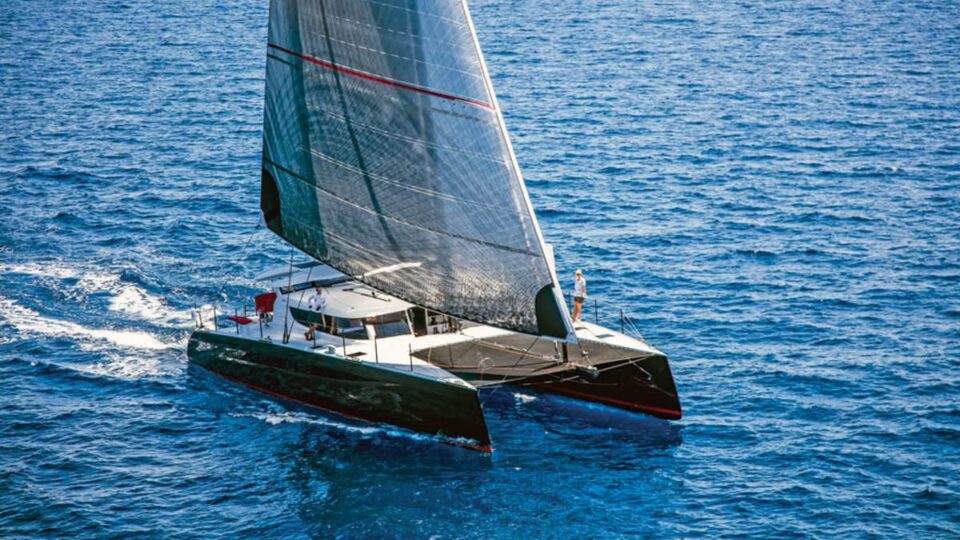
How Fast Do Catamarans Sail? Average Sailing Speed of a Catamaran
In most aspects, sailing a catamaran is very similar to sailing a monohull. If you learn to sail on a monohull then most of the skills are transferable. But, there are a couple of subtle differences that we will analyze further in this article. A catamaran is generally more balanced on the water and can be faster than a multi-hull vessel. And, cruising on a sailboat with a cat hull will be much faster than cruising on a sailboat with a monohull. Therefore, a catamaran hull is able to achieve the speeds of a racing monohull and is also more comfortable to sail on.
A tri-hull is even much better as they’re designed towards the performance end of the spectrum. And that is why they double the speed of a racing monohull. So, let’s analyze this subject further in this article and see what’s the average sailing speed of a cat. Follow me!
Catamaran Vs Monohull Speed: Are Cats Faster than Monohulls?
Not all cruising cats are always faster than an equivalent length monohull. But, many well-designed and balanced multihulls can easily surpass the speed of their monohull cousins. And, it’s not fair to mass all cats into one example, but performance cruising catamarans like the Nautitech or Neel trimarans distinguish from others. Their narrow waterline beams, hull chines, deep and fine keels, and rudders as well as efficient sail plans will typically be faster than the average cruising monohull.
“The fun of sailing is proportional to the speed of sailing”, as an American designer, L. Francis Herreshoff, said. And, it’s basically true because when we sail and see another boat heeling in the breeze, we also feel we want to do the same. This is because for many sailors speed means much more than just fun. You should, however, consider keeping your cat as light as possible if you want to maximize speed. I know that keeping your sailboat light is difficult but it’s of importance if speed is your main goal.
Keep in mind that a boat’s speed has won wars and has also been a contributor to safety. In the past, a fast warship was able to outmaneuver its adversary or escape from a boat with more firepower. And just as proven in history, the speed of a sailboat is important and provides a faster boat with more options.
Monohull VS Catamarans Differences
- When tacking, you must work hard to keep your speed consistent in the tack and always ease the mainsheet to avoid “windvaning.” When the larger mainsail on a catamaran attempts to turn the boat back towards the wind, this is known as windvaning.
- On a monohull, you must be extremely cautious about an unintended gybe. Meaning that you must gybe much more slowly. On a catamaran, you can take advantage of the increased speed and sustain it while gybing to help depower the main.
- On a monohull, and when winds increase, the boat starts heeling. This automatically informs you that you have too much sail up and it’s time to reef. And, as catamarans don’t heel, you have to be very careful when to reef the massive main. Most of the time, you will throw in the first reef at 18-20 knots of wind speed. The second reef will be put as the wind gets closer to 23-25 knots. The above-mentioned always depend on the size and type of your vessel.
Wind as a Main Factor for Speed
Thanks to tech evolutions in radar, satellite, and computer technology, a five-day forecast is as accurate as a two-day forecast was back in 1980. A multihull’s higher speed also contributes to easier and safer planning of ocean passages around weather windows since exposure time will be less. Moreover, meteorological prediction for shorter periods is far more accurate. Keep in mind that when sailing faster you also introduce the concept of apparent wind to the strategy of efficient sailing.
Multihull speed upwind? Sailing upwind, the catamaran usually experiences more apparent wind across the deck since it’s sailing faster. Therefore, the sails will feel more pressure, which will make the boat perform even better. And, of course, the concept of apparent wind contributes to the joy of sailing, as it adds another dimension to it. When sailing towards a downwind destination, fast multihulls are able to sail at smaller wind angles. Subsequently, this brings the apparent wind forward of the beam, hence optimizing the angle of attack on the sails.
While cats will fly gennakers, code-zeros, or asymmetric spinnakers, monohulls mostly set symmetric spinnakers to the poles. And most importantly, their boat speed will often cancel out the true wind and will reduce the apparent wind and performance. The faster the multihull is the more it is able to take advantage of the apparent wind and tack downwind towards its destination. Although it might be sailing twice the distance, it will arrive at the downwind mark quicker because its Velocity Made Good (VMG) will be faster.
>>Also Read: How Fast is a Laser Sailboat? Laser Sailboat Top Speed
Performance Characteristics
Bear in mind that cats require four times the power to double their speed. But, a mono-hull vessel requires eight times the power to double the speed. This is due to the fact that a cat has less resistance in the water. However, this is great in terms of conserving and using less energy. Catamarans are also more stable in the water. This stability is effective at resisting heeling or capsizing. In other words, a multi-hull vessel requires four times the force to capsize as a similar-sized mono-hull vessel.
Most of the time, sailing in a catamaran is smoother and facilitates activities that are not always possible on a mono-hull sailboat. In addition, as catamarans have less water resistance, they are generally faster than mono-hull vessels. As their hulls are smaller, this means that they have a smaller bow wave to fight. The bow wave is a wave created by the displacement of water by the bow of a ship. After a certain speed, the boat has to start hauling itself over its own bow wave. Meaning that the larger hull a boat has, the larger its bow wave will be and the more power will be required in order to fight it.
Since catamarans have two small and narrow hulls, they don’t have much of a bow wave. This is one of the reasons they are normally quicker than a monohull vessel of comparable size. Catamarans can travel at speeds of up to 30% faster than monohull boats. Catamarans have the disadvantage of taking longer to transform than monohulls.
Lastly, the thing that makes monohulls harder to sail is heeling and smaller spaces. In stronger winds, monohulls tend to heel. This results in making most tasks a bit more difficult to perform. Whether you’re heading forward to reef, trying to winch in a sail, or move about the boat, sailing on a heeling boat is always more difficult. However, cats have extra stability and room, and this allows for much easier movement around the boat as they do not heel. And, for this reason, catamarans are often considered easier to sail.
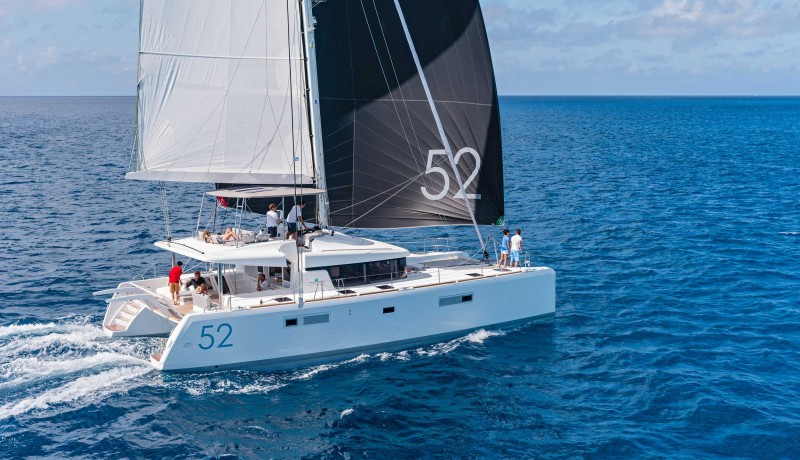
How Fast Are Catamarans Compared To Other Boat Types?
There are two main factors that determine the speed of ships. The first one is the hull type. There are hulls that stay beneath the water more or less than others. But, keep in mind that the less the hull is underwater, the faster it can go. This is due to the fact that the less of the hull underwater, the less the drag created when sailing. The other factor is the length of the boat. And, reasonably, the longer the boat, the faster it can go. Every boat has a maximum hull speed that can’t be exceeded. This can only happen in case the boat can plane on the water’s surface or be lifted on hydrofoils. For most boats, the longer the boat, the higher the maximum hull speed is.
Sailing catamarans typically average about 10 knots while pontoon boats average about 16 knots. As for powerboats, they can average anywhere between 30 and 50 mph. Most average sailboats are designed with monohulls and they average from 6 to 9 knots depending on wind conditions. Generally, sailboats average between 8 and 12 mph, again depending on weather conditions. This includes mono-hull between 6 to 8 mph and cats or trimarans between 9 and 10mph.
Speed and Comfort Considerations For Cats
You have a lot of choices if you choose to buy a catamaran. You have the option of prioritizing speed or comfort. After you’ve decided to buy a catamaran, the type of catamaran you can consider is determined by where you’ll be using it and what you’ll be doing with it. In addition, make sure that you look at what type of water you will be traveling in, your crew members, and what type of speed you want to achieve.
Storage is an important consideration to make before purchasing a catamaran. Due to the beam, or width, of a catamaran versus a regular mono-hull vessel, you are often charged for two slips if you wish to store your boat in a marina. Moreover, catamarans are a great option for those who get seasick because they have a more stable ride and more open air space. You have more windows and visibility since the living quarters are not within the hull and below the water’s surface.
Sailing and power catamarans are both great choices. In addition, for low winds or conditions such as docking in a marina, sailing catamarans may be equipped with backup power engines. Twin-engine catamarans can have more power and precision than mono-hull vessels.
>>Also Read: How Fast Can Sailboats Go?
Main Advantages of Catamarans
- Space! If you want to opt for more interior and exterior space then the two separate hulls of a catamaran can often double the amount of social space than a monohull of the same length.
- Catamarans are far more stable than monohulls. For this reason, they don’t heel when sailing, and are less prone to rocking when at anchor. This factor also contributes to comfortable sailing.
- Catamarans have a shallow draft which allows them to enter shallower areas. Keep in mind that in the South Pacific, most lagoons are 6 to 8 ft in depth. This depth doesn’t allow for monohulls to enter, but a catamaran can easily enter these areas.
- Stability is another big plus of cats. A cat isn’t that susceptible to the effects of wave action and it also doesn’t heal the way a monohull does. Therefore, it’s much easier to walk around on deck and within the interior of the cat while underway.
- In terms of speed, and mostly for downwind sailing , cats are faster than monohulls. This particularly applies to downwind runs, reaches, and broad reaches.
- More light, customizable, and airy living area. On a catamaran, the living space is usually situated in the middle of the boat and built on the bridge deck. But, in a monohull you go down into the hull where it is darker and less airy.
- More storage space and room for extra systems, provisions, and general sailing equipment. These may include air conditioning, heaters, oven, watermakers, generators, larger fridges, and freezers, etc. And, if you’re a liveaboard, then living on a cat is far more comfortable than living in a sailboat. You have more interior, exterior, and storage space as well as stability and speed in terms of sailing performance.
- Many modern cats have flybridge helms. And of course, no monohull achieves this visibility from the helm provided on most modern catamarans.
- The galley, main salon, and cockpit are all located on one level , above the waterline.
- Because the majority of living space is above the waterline , there’s a better flow of ventilation on a cat making the need for air conditioning somewhat less important during the daylight hours.
- When you plan to set sail, you almost never have to rush around stowing stuff or using bungee cords to hold things in place. Except in relatively rough waters, most things stay put.
- Since catamarans lack a large, heavy keel filled with lead, they can float even if they’re holed. Production cats are constructed with so much buoyancy that sinking them is nearly impossible.
- Catamarans are usually easy to dock because you have two motors and two rudders. Additionally, there’s also no need for a bow thruster.
- Most catamarans are able to turn 360 degrees within their own length.
Average Sailing Speed of Catamarans
| Sport Catamarans | 30 knots |
| Cruising Catamarans | 15 knots |
| Racing Catamarans | 45 knots |
| Power Cruising Catamarans | 70 knots |
| Swath Catamarans | 30 knots |
How Fast Do Catamarans Sail? – The Bottom Line
Bear in mind that not all catamarans are created equal. In other words, catamaran speed is relative. The most important benefit of the speed of a multihull is the ability to outrun bad weather. Meaning that you’re able to average 9-10 knots on a catamaran rather than 6-7 knots on a monohull. Subsequently, this will give you more options in your strategy to avoid bad weather. In general, sailing catamarans typically average about 10 knots. Higher maximum and average speeds are what makes cats distinguish as well as their stability. These are the most important characteristics which makes many sailors prefer cats rather than monohull boats.
Peter is the editor of Better Sailing. He has sailed for countless hours and has maintained his own boats and sailboats for years. After years of trial and error, he decided to start this website to share the knowledge.
Related Posts

Atlantic vs Pacific: Which is More Dangerous for Sailing?

Lagoon Catamaran Review: Are Lagoon Catamarans Good?

Best Inboard Boat Engine Brands


Are O’Day Sailboats Good? A Closer Look at a Classic Brand
- Buyer's Guide
- Destinations
- Maintenance
- Sailing Info
Hit enter to search or ESC to close.
How SailGP’s foiling F50 catamarans sail so much faster than the wind

Arguably the most technologically advanced sailboats on the planet right now, the one-design SailGP F50 foiling catamarans are capable of breathtaking speeds – at times, reaching four times the velocity of the wind that drives them. But how do they do it?
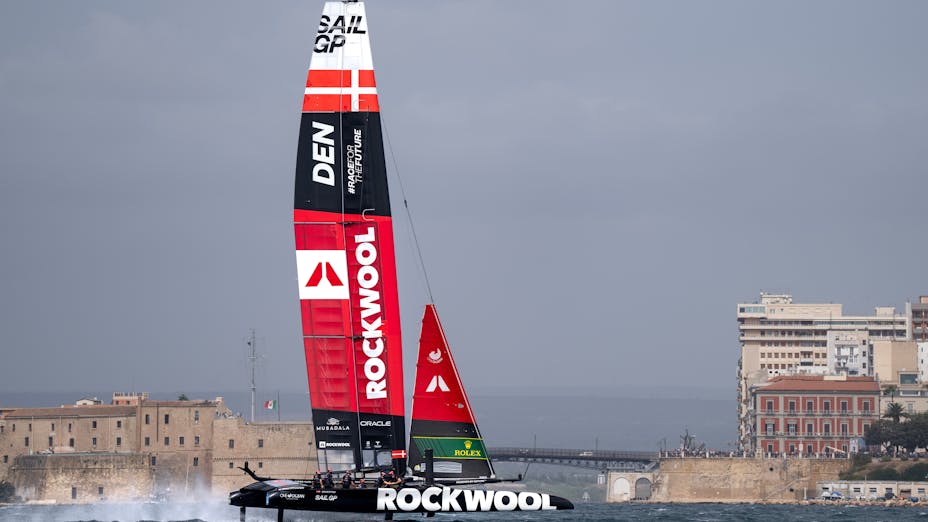
Beating the balloon

Bending the laws of physics

Faster and faster

Beneath The Surface
Watch on youtube.
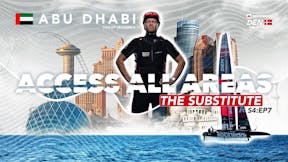
Access All Areas
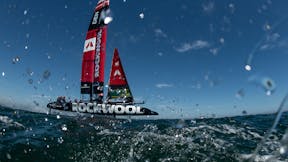
Want to learn more about SailGP?
Meet the denmark sailgp team, find all the latest news, go beneath the surface of sailgp, sailing terms, go beneath the surface.
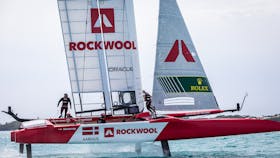
How the world’s fastest sail racing boats fly above the water
Tune in to SailGP’s landmark Season 2 opener in Bermuda at the end of the month, and you’d be forgiven for thinking that your eyes are deceiving you.

The Beneath The Surface show
We go Beneath The Surface of SailGP's iconic host cities, set a spotlight on great projects and curious mind and catch all the lastest with the Denmark SailGP Team. Join us as we travel the world and explore how innovation and science is helping solve the world's biggest challenges!
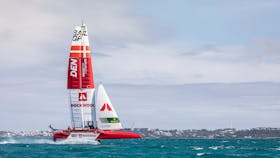
This is how SailGP's NASA-inspired wings make the F50 boats fly
Some may say the foils, which help the boats to fly above the water. Others may claim it’s the platform – that’s the two, catamaran hulls and the trampoline that connects them.

ROCKWOOL Denmark SailGP Team
The official home of the ROCKWOOL Denmark SailGP Team. Meet the team, read all the latest stories and explore a world of exciting content.

ROCKWOOL Group

17 Best Catamarans for Sailing Around the World
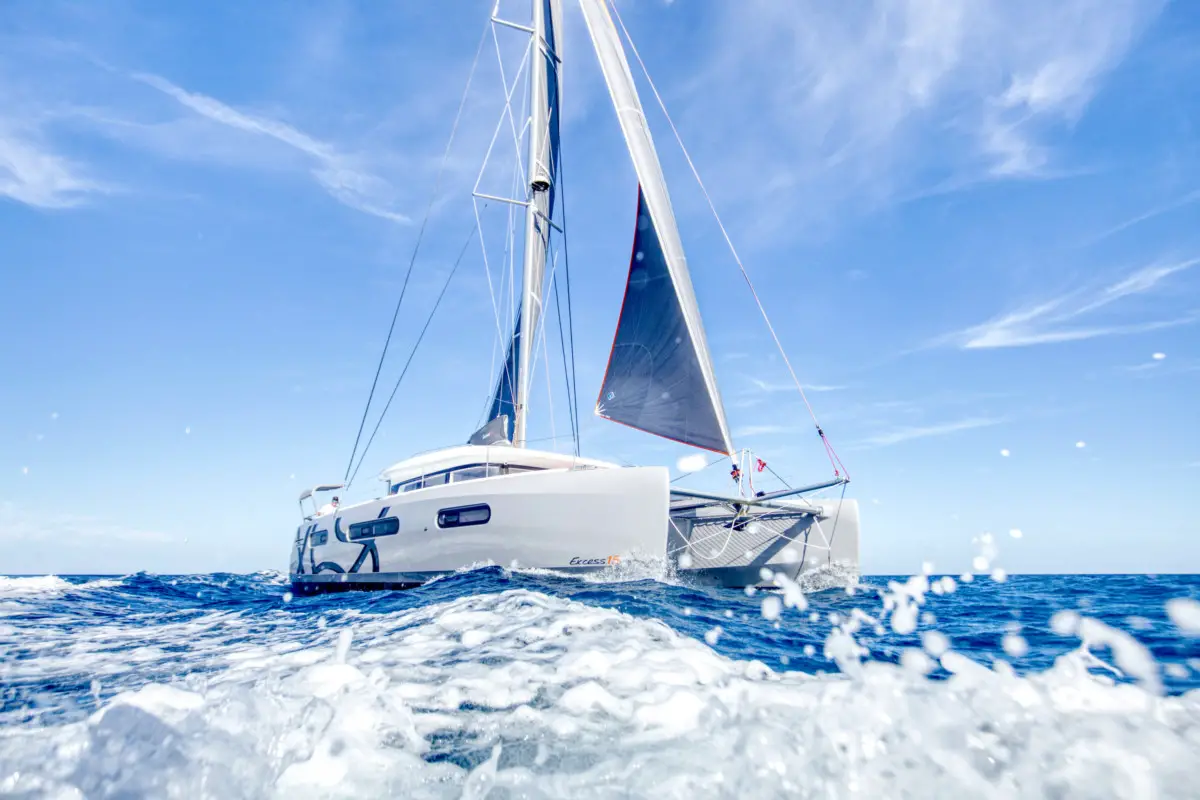
As an Amazon Associate, we earn from qualifying purchases. We may also earn commissions if you purchase products from other retailers after clicking on a link from our site.
Catamarans are quickly outstripping single-hull boats for long-distance journeys. They are more stable and comfortable , and some can travel more than 200 miles in a day. In today’s article, I have put together a complete (well almost) list of some of the best catamarans for circumnavigating the planet; the question is, which one is best for you?
The best catamarans for sailing around the world include:
- The Fountaine Pajot Ipanema 58
These cats focus on speed, safety, and comfort for longer journeys.
This article will show you the seventeen best catamarans for long journeys, and why they’re the best. You’ll also learn some great tips on what to look for in a Catamaran and how to save money by buying a used catamaran. Let this list be a jumping-off point for your future research!
Pro-tip; here are the actual costs of maintaining a cat and here are considerations on how to circumnavigate .
Table of Contents
The Best Catamarans for Sailing Around the World
A catamaran is a double-hulled boat with a deck or cabin area in between (bluewater cat definition in this article ). The double hull design means that the boat rocks less, sits higher on the water, uses less fuel to sail, and can be sailed in shallower waters than a single-hulled boat without worrying about grounding.
Catamarans come in a variety of sizes and can be sail-powered or motor-powered and range from single-person sailing boats to family-sized yachts. Every catamaran design is different, and the twin-hull shape offers many ways to customize the layout of a ship.
Each boat on this list is a larger catamaran (+40ft, more on size here ), so if you’re going to sail around the world, you want lots of space for provisions and rest.
Of course, there are tons of technical specs for each of these boats, but I’m going to focus on the overall features of each of these catamarans, what makes them stand out, and why they would each be an excellent choice for a transatlantic journey.
Antares 44i
The Antares 44i is an excellent option for sailing around the world and was explicitly designed for long-distance cruising. It performs well in any weather conditions, can be sailed easily by two people, and you’ll be able to sail long distances and live in comfort.
Although it can be easily sailed by a crew of two I believe that a true bluewater cat should be set up for single-handed sailing, more on that in another article .
This catamaran features a stateroom on each hull and a forward cabin with plenty of storage space. The living and entertainment features include a flatscreen tv and a high-end deck speaker system.
With this model, Antares dedicates itself to high-quality boats with optimal rigging and engine configurations.
Atlantic 42
Atlantic is no longer building this catamaran, but there are usually a few pre-owned boats on the market. You can also get it made custom if you love the design, but be prepared to spend more money on a custom boat (custom boat also gets custom problems ;)).
The Atlantic 42 is slightly smaller than some of the other catamarans on this list but is a seaworthy vessel. 42 ft is what most sailors I interview ( in this article ) said was the smallest cat to safely cross big oceans. It is also a decent size to counter the risk of capsizing (more on that here ).
It has a forward cockpit and pilothouse, which gives the owner a better use of space and makes the boat easier to navigate. With single-handed capability, one person can sail it easily and let the rest of the crew relax.
One of the best-praised aspects of the Atlantic 42 is its galley, more extensive than most 42-footers (12.8-meter) can offer.
One of the few 50 footers (15.24 meters) that can be sailed by just one person (many would of course disagree on this).
The Catana 50 is a catamaran worthy of an overseas journey. Its size adds to its stability on the open waters and its ability to sail straight through the choppy ocean and windy conditions.
The Catana is also incredibly spacious on the inside, with substantial cabins and showers. The biggest downside to the Catana 50 is its price, as it’s much more expensive than most of its competitors.
Catana also holds up well against some of the fastest cruising cats out there, here’s a list of the fastest cruisers if you are interested in that.
However, if you can find a gently-used Catana 50, you can rest assured that this boat will last!
The Dolphin 42 is unique because of the use of daggerboards instead of fixed keels. This upgrade means that the boat has some pretty decent upwind performance while at the same time being faster downwind.
Centerboards and daggerboards offer some interesting downsides compared to mini keels. This is an interesting discussion and I suggest you read another one of my articles if you want to deepen your knowledge a little.
These catamarans are some of the lightest on the market. Not many Dolphins were made, so they are relatively hard to find. However, if you want a small, lightweight boat capable of going great distances, the Dolphin 42 is an excellent choice.
Fountaine Pajot Belize 43
The Fountaine Pajot Belize is another well-built cruising yacht. Its core is made of foam instead of balsa, which reduces the risk of structural damage due to a rotten core in case of water intrusion.
The design of Belize offers many options for customizability, with large open spaces and a combined saloon, navigation, and dinette area.
There are two styles of Belize catamarans for sleeping quarters. You can either purchase a boat with an entire primary suite on one hull or one with two cabins in each hull. The first option is great if you are sailing the world alone and not expecting many guests, as it increases the storage capacity.
Understanding what factors to consider when getting a cat can be hard, there are just so many of them (such as the daggerboard discussion above), I have tried to compile some of the most important in this article .
The boat also has wraparound windows to increase the sense of space in the galley.
Fountaine Pajot Lucia 40
Fountaine Pajot is one of the best sailboat manufacturers existing today, as their boats are well made and highly versatile. The Lucia 40 is no exception – it’s a smaller boat but has a lot of room for moving around and on-board living.
The living area is remarkably spacious on this catamaran for its size.
The galley and lounge easily accommodate 6+people. The Lucia 40 doesn’t disappoint when it comes to sailing either, as the narrow hulls slice through choppy waters with ease.
Most catamarans today are built to withstand rough weather but that doesn’t matter as much if the crew isn’t up for the task, I firmly believe that the most important thing a boat should consist of, is knowledge. Therefore taking online courses ( two free here ) or reading books ( my favorites here ) is imperative.
Gemini 105M
Gemini’s boats have been on the market for years and are solidly built for cruising. This boat is one of the most popular ever made, I personally would consider something different for offshore cruising, but since it has such a good reputation, I felt I had to add it to the list.
If you want to understand why I am hesitant to take this boat around the world, I recommend you read my article: What are trampolines on a catamaran?
The Gunboat 62 is a great catamaran and set the standards for the rest of the impressive Gunboat lineup. It’s sleek and spacious while being robust and capable of transatlantic journeys. You can easily travel the world in a Gunboat 62 with several people and not feel cramped.
The yacht was made for speed and power and remains one of the fastest catamarans on the market, even rivaling the newer Gunboat models. GABO
Although the earlier models of the Gunboat 62 weren’t designed for a lot of cargo, you can still find space for everything you need without compromise.
Lagoon catamarans are known for their reliability and ease of use. If you are considering a catamaran for the first time and are unsure about the technicalities of sailing, a Lagoon boat is a great option.
The Lagoon 380 is probably the smallest cruiser on this list, which makes it better suited for solo or couple sailing.
When I go looking to buy something, whether it be a boat, campervan, or whatever, I create a checklist and classify all the things I want either by NEED or NICE to have.
I believe the Lagoon 380 to be sub-optimal for my NEEDS, even though it does check a lot of NICE boxes, there’s a step-by-step article on the NEED and NICE method here .
There are several cabin options available on the Lagoon 380, but if you’re sailing by yourself, you can settle for three cabins and a larger galley and living space. With a smaller cockpit and broader side decks, the Lagoon 380 packs a lot of practicality and ease of sailing into a more compact catamaran.
If you like the idea of a Lagoon boat but want a little more space, the Lagoon 42 is the upgraded version of the Lagoon 380. With all of the same benefits, it comes with more space for cabins or storage, making it one of the best-selling Lagoons of all time.
The Lagoon 42 is also a faster cruiser built for strength. While it’s not the fastest on the market, it works well in choppy waters and windy conditions, making it great for the beginning sailor to go on a more extended trip.
Many people have completed an around-the-world sail with this ship.
Although there is a flybridge version, I would recommend the “open” version due to several factors, some including increased windage and a higher boom. More on flybridges pros and cons here .
For stability, safety, and durability, you can’t beat the Lagoon 42.
The Leopard 45 performs better with less storage weight because of the relatively low bridge deck clearance. If the boat is fully loaded, you could experience some wave pounding. However, the cockpit is open and airy, with devices that block the sun and provide maximum comfort while sailing.
The Leopard 45 is an incredibly beautiful boat, and has a strong reputation for excellent build quality!
Leopard catamarans are one of my personal favorites, as such I have written an entire article about the brand, so if you want to understand its pros and cons then here is the link . Gabo
Designed in South Africa, it features a high rear arch for extra support and very smoothly connected decks. The galley is large and open, and most Leopards offer a four-cabin plan. If you are traveling with another person, this boat is an excellent option for you!
The Manta 42 is another classic catamaran that you can buy used (at a decent price), as it is an incredibly seaworthy vessel. While still in production, the Manta was one of the most popular catamarans on the market.
It is still in high demand amongst circumnavigators. Buying a used Manta 42 usually means that you inherit some of the previous owner’s boat upgrades!
The Manta 42 also made it to my list of the 9 safest catamarans on the market ( link ).
This blue water cat can be sailed by one or two people, making it ideal for liveaboard couples or long-distance shorthanded sailing. The galley is in the saloon ( instead of in one of the hulls ), making the cabins below more spacious and better equipped.
Overall, the Manta is well equipped for sailing around the world.
Nautitech 44
Nautitech is an excellent brand of the catamaran, with several different designs per boat. The Nautitech 44 has a unique feature, you can have it with two options for steering: twin wheels or a single wheel.
The Nautitech 44 also features a cockpit on the same level as the saloon. The door between the two is more convenient than a hatch and dramatically reduces the risk of water damage during rain pour.
This is also the same boat that aeroyacht president Gregor owns, he has offered some great insights into Nautitech in the book Catamarans (amazon link )
Outremer 45
Outremer is famous for being one of the fastest brands of catamarans on the market. If you need speed, the Outremer 45 might be the perfect choice for you. It has a top speed of 16 knots, which is higher than almost every other catamaran of its class.
While the Outremer 45 is known for speed, it doesn’t compromise on the quality of living.
You can settle into life on this boat with complete peace of mind. Even as a beginning sailor, the steering is simple and easy to use, and the autopilot is top of the line, so you’ll be able to sail across the ocean in an Outremer without issue.
Privilege Serie 5
A French-designed catamaran, the Privilege Serie 5 is one of the most comfortable 50-foot (15 m) yachts available. The unique cabin layout includes the master cabin in the boat’s center instead of in one of the hulls.
The Privilege Serie 5 is also incredibly easy to sail, despite its larger size.
The sails and controls lead to the helm, where the raised deck makes it easy to see all around the deck. If you want to cross the ocean with a full crew then the Privilege Serie 5 might be perfect for you!
Seawind 1000
The Seawind 1000 is the smallest boat on this list, measuring 33 feet (10 meters) long altogether. However, this doesn’t mean that it’s not livable. If you are sailing on your own or with a partner, there is more than enough space to live in the Seawind 1000, which includes the option of a centered cabin or two hull cabins.
Because it’s small, the Seawind 1000 is easy to handle. The mast and sails are all manufactured for extra stability and ease of use.
Overall, the Seawind 1000 is an excellent example of a simple, safe, and seaworthy catamaran.
Note: since this is a small catamaran it will also be more sensitive to heavy weather so trip-planning becomes even more important.
The Voyage 44 is one of the oldest cats on this list, having had its hay-day in the mid-1990s. However, this also means that a used Voyage 44 will be cheaper than a newer boat. If you can find a Voyage with previous responsible owners, you will inherit any upgrades and fixes that they’ve made on top of a very seaworthy boat.
The Voyage 44 has more storage and space than most cruisers of its size and is known for behaving very well in choppy waters.
This catamaran does its job well while providing adequate space for cooking, sleeping, and living aboard.
What To Look For in a Long-Distance Cruising Catamaran
If you are planning to sail around the world, you need to be very careful about which kind of catamaran you decide to use. Many of the things you want in a boat really comes down to personal preference, so be sure you know what design preferences you want before you start shopping!
Size and Payload
The most important thing to consider when buying a catamaran is how much space and cargo you need because the larger the boats are, the bigger the payload it can handle. Decide how long you want the ship to be and how much you’re taking with you.
It’s vital not to overload a catamaran, this will reduce performance and increase risk of unwanted behavior in heavy seas.
Cabin Placement
Most catamarans have options for a “Maestro” cabin placement, where one entire hull is the master suite, and the other cabins are located on the opposite hull.
Cockpit and Protection From The Weather
Is the cockpit on the boat you’re looking at covered or open? This can make a difference on the high seas, especially during rainy weather.
The size of the ship also can affect how many people you need as a crew. If you’re traveling by yourself or with one other person, you don’t want to buy a boat that needs a larger crew.
Buying Used?
If you don’t want to spend the money on a brand new catamaran, I don’t blame you. Several of the ships on this list are out of production and can only be found used. However, for circumnavigation, you do want a boat of high quality to keep you safe and dry until you make it to your destination.
When buying a suitably used catamaran, it’s essential to look at the refit history of the boat more than the year it was made. Catamarans are sturdy, and the general design has been the same for at least the past decade.
If you find a newer, larger, cheaper boat, you should look into its history.
Your best bet to save money while buying a catamaran will be to buy an older, probably smaller boat with an excellent refit history and no serious issues. It will still be an investment, and a sturdy used catamaran will serve you well.
Final Thoughts
No matter which catamaran you decide to buy for your journey, you’ll be able to sail safely and comfortably. Catamarans are great yachts for long-distance sailing, and the ships on this list are the best of the best. These brands are time-tested and ready to accompany you on an adventure around the world!
Here are Some of My Favorite Catamaran Cruising Resources
Thank you for reading this article. I hope you found it helpful as you hopefully start your sailing adventures. Here are some resources that I use as a sailor that I hope you’ll also find helpful. These are affiliate links, so if you do decide to use any of them, I’ll earn a commission. But in all honesty, these are the exact things that I use and recommend to everyone, even my own family. Sailboats: If you’re looking for the best boat to suit your needs, I would recommend a catamaran. If you’re interested, I can show you the differences between catamarans and other types of sailboats .
Books: For getting started, I really like Cruising catamarans made easy . It is actually a textbook from the American sailing association; it is used to get a cruising catamaran certification. There are some other great books, and I have compiled a list of books about cruising catamarans that you will find useful.
Communication: Being out on adventures, whether it be sailing or climbing mountains, good communications are essential to being safe. I recommend two things Google fi (incredibly simple cellular data all over the world) and Garmin inreach mini (for text and voice in remote areas without cell coverage)
Sailing courses: Online sailing courses are great for beginners starting out their sailing career; it’s an efficient way of learning the basics of navigation, throttle controls, and maritime safety. I suggest starting with two free courses from NauticEd .
To see all my most up-to-date recommendations, check out this resource that I made for you!
- Wikipedia: Catamaran
- Cruising World: A-Z Best Cruising Catamarans
- Dreamy Yacht Sales: Four Best Catamarans for New Buyers
- Atlantic Cruising: Good Cat/Bad Cat
- Yachting World: Catamaran Sailing Across the Atlantic
- Boat Affair: What is a Catamaran?
- Nautilus Sailing: Catamaran Sailing
Owner of CatamaranFreedom.com. A minimalist that has lived in a caravan in Sweden, 35ft Monohull in the Bahamas, and right now in his self-built Van. He just started the next adventure, to circumnavigate the world on a Catamaran!
3 thoughts on “ 17 Best Catamarans for Sailing Around the World ”
I like the efforts you have put in this, regards for all the great content.
Thanks Elisabeth I really appreciate the kind words 🙂
I appreciate you sharing this blog post. Thanks Again. Cool.
Leave a Reply Cancel reply
Your email address will not be published. Required fields are marked *
Save my name and email in this browser for the next time I comment.
Recent Posts
Must-Have Boat Gear for Catamaran Sailors!
Sailing is probably the most gear-intensive activity I've ever done; there are so many decisions to be made about what gear to buy now, for tomorrow, and what to definitely never buy. The gear on...
6 Best Trailerable Trimarans For Bluewater and Coastal Sailing
Having a boat costs a lot of money, even when you are not using it, marina fees, etc. And once it is in the water most sailors never go very far from their "home marina" and sailing will be somewhat...
Driving and Docking a Catamaran: Guide for Boaters
Catamarans have grown in popularity among boaters, both for recreational sailing and long-distance cruising. With their dual-hull design, they offer stability, speed, and ample space. However, driving and docking a catamaran is a unique experience compared to single-hull boats. This guide will take you through the essentials of operating and maneuvering a catamaran, covering its driving characteristics, docking tips, common challenges, and an overview of pricing and specifications for some popular models.
What Is a Catamaran?
A catamaran is a boat with two parallel hulls connected by a deck or bridge. This design provides more stability and reduces drag in the water, making catamarans faster and more efficient than monohull boats. Catamarans are known for their spacious interiors, increased living space on the deck, and shallow draft, making them perfect for coastal cruising and anchoring near shores.
There are two primary types of catamarans: sail-powered and power catamarans. Each has unique driving and docking considerations, which we’ll explore below.
Driving a Catamaran
Understanding the dual hulls.
Driving a catamaran differs from operating a monohull because of the boat’s width and the twin hulls. Here’s how the catamaran design affects driving:
- Stability : The wide stance of the hulls makes catamarans more stable, reducing rolling in rough seas. However, it also means they handle differently when turning and responding to wind or current.
- Manoeuvrability : Catamarans are agile, especially power catamarans, due to the ability to control each hull’s engine independently. This gives them better control, especially when docking or navigating tight spaces.
- Wind Influence : Catamarans are more susceptible to wind because of their large profile and lightweight design. Sail-powered catamarans especially benefit from their ability to harness wind, but this can make them tricky to drive in strong winds when compared to monohulls.
Key Differences in Driving a Catamaran
- Speed and Efficiency : Catamarans glide across the water with minimal drag, making them more efficient and often faster than their monohull counterparts. When driving, you’ll find that maintaining speed requires less fuel or wind power.
- Turning Radius : Catamarans tend to have a wider turning radius, requiring more space to make turns. However, with dual engines (on power catamarans), you can pivot the boat using differential thrust, making it possible to spin in place.
- Handling Waves : Unlike monohulls that cut through waves, catamarans ride over them. This makes for a smoother experience but also means that waves can impact both hulls differently, requiring you to adjust your steering.
Docking a Catamaran
Docking a catamaran requires a combination of skills and careful attention to the conditions. The wider beam, lighter weight, and susceptibility to wind present unique challenges. However, with some practice, catamarans can be docked smoothly and efficiently.
1. Approach at an Angle
When docking a catamaran, the first rule is to approach at an angle. This gives you more control and allows you to adjust for wind and current. A slow, controlled approach will help you compensate for any unexpected movements.
2. Use Differential Thrust
If your catamaran is equipped with twin engines, you can use differential thrust to your advantage. This involves using more throttle on one engine and less on the other to make precise movements, including rotating the boat to line it up with the dock.
3. Mind the Wind
Wind can have a significant impact when docking a catamaran, especially if the boat is light. Always dock into the wind if possible, as this gives you better control. If the wind is pushing you toward the dock, approach more slowly to avoid collisions.
4. Use Fenders and Lines
The width of a catamaran makes fender placement especially important. Place fenders along both sides of the boat to avoid damaging the hulls. Additionally, set up docking lines in advance, as this will help you secure the boat once it’s close to the dock.
5. Shallow Draft Considerations
One advantage of catamarans is their shallow draft, which allows you to dock closer to shore in many situations. However, be mindful of the depth and obstacles near the dock to prevent damage to the rudders or keels.
Common Challenges When Docking a Catamaran
- Wide Beam : The wide stance of a catamaran can make finding appropriate dock space more difficult, especially in crowded marinas.
- Windage : Catamarans are more susceptible to wind, especially when docked in open areas. Wind can easily push the boat off course, making docking more challenging.
- Limited Docking Space : Some docks aren’t designed to accommodate the wider beam of a catamaran, which may require special arrangements or berthing in less accessible areas.
Price and Specifications of Popular Catamarans
To help you understand the range of options available, here’s a look at a few popular catamaran models, including their specifications and price ranges.
1. Lagoon 42 (Sailing Catamaran)
- Length : 42 feet
- Beam : 25 feet
- Draft : 4.1 feet
- Engine : 2 x 57 HP
- Top Speed : 9-10 knots under sail
- Price : $600,000 – $750,000 (new)
- Features : The Lagoon 42 is a favorite among cruising enthusiasts, offering ample living space, a large cockpit, and easy handling. It’s ideal for long-term cruising and comes equipped with various modern amenities like solar panels and watermakers.
2. Fountaine Pajot MY 44 (Power Catamaran)
- Length : 44 feet
- Beam : 21.7 feet
- Draft : 3.8 feet
- Engine : 2 x 350 HP Volvo Penta
- Top Speed : 25 knots
- Price : $1.2 million – $1.5 million (new)
- Features : This luxury power catamaran offers high-performance engines, exceptional maneuverability, and a spacious, modern interior. With its twin-engine setup, docking is a breeze, and it’s perfect for long-distance cruising.
3. Leopard 45 (Sailing Catamaran)
- Length : 45 feet
- Beam : 24 feet
- Draft : 4.10 feet
- Engine : 2 x 45 HP
- Top Speed : 9-11 knots under sail
- Price : $700,000 – $850,000 (new)
- Features : Known for its robust build and reliability, the Leopard 45 is a versatile sailing catamaran that offers a well-appointed layout, plenty of deck space, and easy access to the helm for simplified docking.
4. Sunreef 50 (Luxury Catamaran)
- Length : 50 feet
- Beam : 30.8 feet
- Draft : 5.7 feet
- Engine : 2 x 80 HP
- Top Speed : 12 knots under sail
- Price : $1.7 million – $2.5 million (new)
- Features : Sunreef catamarans are synonymous with luxury. The Sunreef 50 is a perfect example, featuring expansive living quarters, a luxurious master suite, and customizable layouts. It’s ideal for those looking to cruise in style.
Driving and docking a catamaran is an exciting and rewarding experience, but it comes with unique challenges. Whether you’re handling a sailing catamaran or a power catamaran, understanding how to control the vessel’s dual engines, accounting for wind, and mastering differential thrust are key to a smooth ride and docking. With time and practice, you’ll find that catamarans offer unparalleled comfort, performance, and stability on the water.
If you’re considering purchasing a catamaran, it’s essential to consider your boating style, desired features, and budget. From the agile Lagoon 42 to the luxurious Sunreef 50, there’s a wide range of catamarans available, each designed to provide a unique experience on the water.
Whether you’re a seasoned sailor or new to boating, mastering the art of driving and docking a catamaran will open up a world of adventure on the open sea. Happy sailing!
Happy Boating!
Share Driving and Docking a Catamaran: Guide for Boaters with your friends and leave a comment below with your thoughts.
Read How to Choose a Life Raft for Your Boat: The Complete Guide until we meet in the next article.
Similar Posts

Top Rated Aluminum Fishing Boats: A Comprehensive Guide
Aluminum fishing boats are a favorite among anglers for their durability, lightweight construction, and versatility. Whether you’re a seasoned fisherman or a beginner looking to get into the sport, finding the right aluminum fishing boat can significantly enhance your experience on the water. This guide will cover the top-rated aluminum fishing boats, examining their features,…

A Guide to Boating Certification: Setting Sail Safely
The call of the open water is undeniable, but before you can captain your own vessel and explore hidden coves or serene lakes, acquiring proper boating certification might be necessary. While regulations vary by location, boating education equips you with the knowledge and skills to navigate safely and responsibly. This guide will demystify boating certification,…

Pontoon Boat Trolling Motor Shaft Length: What to Know
When it comes to outfitting your pontoon boat with a trolling motor, one of the most crucial decisions you’ll need to make is selecting the correct shaft length. The shaft length of a trolling motor is not just a minor detail; it plays a significant role in ensuring your motor performs optimally and that your…

Garmin Striker vs. Echomap (Key Differences Explained)
Picture this: you’re out on the open water, the sun dancing on the ripples, and the thrill of the catch beckoning. For anglers, this is paradise. But, in the vast expanse of water, finding the perfect fishing spot can be like searching for a needle in a haystack. That’s where a reliable fishfinder becomes your…

Holland’s Boat Shop: Crafting Exceptional Maine-Built Boats
Nestled in the heart of Belfast, Maine, lies Holland’s Boat Shop, a family-owned business with a rich history of crafting exceptional working lobster boats. For over five decades, the Holland name has been synonymous with quality, durability, and a deep understanding of the unforgiving waters of the North Atlantic. A Legacy Built on Tradition The…
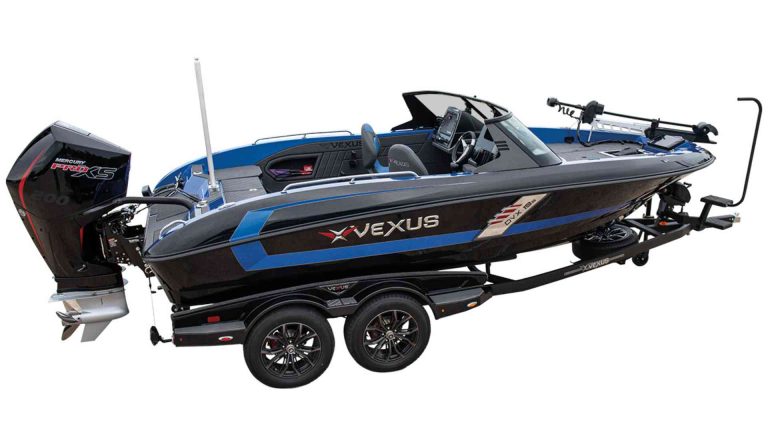
8 Common Problems with Vexus Boats
Vexus boats have swiftly ascended the ranks in the boating world, captivating enthusiasts with their innovative designs and superior performance. Their popularity is undeniable, as more and more boaters opt for the Vexus experience. Yet, like any vessel that ventures into the open waters, Vexus boats are not impervious to the occasional challenges that come…
Yachting World
- Digital Edition

Catamaran sailing: expert multihull techniques
- Nikki Henderson
- February 18, 2022
Moving to a performance multihull can be a leap for even the most experienced cruiser. Nikki Henderson shares expert multihull techniques.

There has been a huge surge in the sales of performance multihulls and with them a need to know how to handle them particularly when it comes to specific multihull techniques. The market for these boats is broadening; multihull cruisers are upgrading, monohull sailors are upsizing, and even virgin boat owners are tempted.
Over the last 12 months, while coaching for Outremer , I’ve met hundreds of these owners, everyone from young families to retired couples moving aboard a new catamaran and setting sail on a circumnavigation. Handling a performance catamaran is achievable even for a novice multihull sailor. But there is a big difference between just ‘getting by’ on such a boat versus sailing efficiently, safely and in style.
The transition for even experienced sailors can be quite a step up. For a seasoned monohull sailor, the differences are obvious: increased volume and speed, and a lack of heel. Even for an existing multihull sailor, the handling and performance is noticeably less forgiving and requires a shift in focus and technique.
This winter, I set sail on a transatlantic with the new owners of an Outremer 55 . They have previously owned another less performance-orientated catamaran but invited me on board to coach them to fine tune the boat, assist with routing, and help them take best advantage of all the performance their new yacht offers. Here are a few of the topics we focussed on:

sailing at higher speeds will change everything from manoeuvre techniques to weather routing. Photo: Robin Christol/Outremer
Most non-planing monohulls will do approximately the same speed on all points of sail. However, a performance multihull might sail at twice, three, even four times its upwind speed on a reach.
For example, the factory polars of an Outremer 55 give its average speed in 20 knots of wind with a true wind angle (TWA) of 50° at 8.5 knots, but in the same windspeed with a TWA of 110° it’s 19.1 knots. That’s more than twice as fast. How do you make the most of this speed advantage? And how do you best manage it ?
In a monohull it often pays to slog it out for days sailing the best course to windward as this normally gives the best velocity made good (VMG). A dead downwind rhumbline route is the usual strategy for longer ocean passages, rather than sailing more miles and wider angles.However, on a performance multihull it is important to prioritise reaching when route planning.

aboard high performance catamarans, such as this TS42, you can race competitively in offshore events. Photo: Jacques Vapillon/Sea&Co
In upwind conditions on a long crossing, consider whether bearing off by even as much as 20° will result in a better VMG, even if it feels counterintuitive. In light winds bearing off to 70° or 80° TWA can be the difference between a totally stalled boat and 5 knots of boat speed .
Faster speeds open up the possibility of keeping up with pressure systems as they move around the globe. For example, if crossing the North Atlantic eastwards, ideally you’d leave the US in clear weather with a depression forecast to leave the American coast a few days later.
You could use its predicted track to decide how much north or south to add to your easterly heading, to ensure that as it catches up with you, you are sufficiently south enough of it to pick up its strong westerlies. As they approach, you will accelerate, and if you can hold the speed you can use that downwind airflow to push you most of the way across the pond.
Handling at speed
Controlling and handling the boat at these higher speeds requires a change in strategy. Increased speeds and acceleration mean that the apparent wind angle and apparent wind speed change much more frequently. So you need adaptable and flexible trimming and driving solutions.

Use twist to balance power and control. Photo: Robin Christol/Outremer
Downwind the boat should be carving S-curves through the water to ensure it achieves the best VMG possible. If you can get this right you will attain the momentous double figure average speeds that a performance multihull offers, while also going the right direction! Instead of allowing the speed to plummet at the end of each surf, as the bow sinks into the bottom of the wave, a performance multihull can just keep on going.
How to maintain speed:
1 Sail at higher angles to build up apparent wind speed (AWS) and boat speed.
2 Soak downwind as the apparent wind angle (AWA) surges forward with the acceleration.
3 Drive the boat back slowly upwind in time to maintain the average speed and continue the surf.
In an ideal world, to achieve this the boat would be hand-steered. But realistically, no cruisers want to be on deck for two weeks straight on a transatlantic crossing. Your best compromise is to invest in a top quality, well set up autopilot, as well as good wind instruments.
Set the autopilot to sail to apparent wind angle and watch how the boat slaloms through the ocean. The quality of the autopilot will really start to show its value when the sea state starts to increase. The best ones improve over time as they collect data and learn the wave patterns. If you aren’t sure exactly which AWA is ideal, choose a day that has very consistent wind and sail in open water. Set the autopilot AWA to 90° and then systematically increase the setting by increments of 5° at fixed time intervals until you get as low as you can before the foresail is shadowed behind the main. Measure the VMG by comparing the distance travelled at each of the different wind angles, and the average A to B course over ground (COG) achieved. This will give you a good starting point, and then it will shift further depending on sea states and wind strengths.
Sail setting
Another solution if you want fast speeds but don’t want to actively sail the boat to within an inch of its life is to use twist. Twist is a compromise between having a hardened sail that stalls when the wind goes aft, or a very eased sail that luffs when it goes forward. The more changeable the conditions, the more extreme the acceleration increases are, or the rougher the sea state is, the more twist you need.

Cats have the space and stability to hoist and douse, so keep weight low by dropping flying sails when not in use. Photo: Christophe Launay
The wide beam of a multihull allows for a long traveller, so most won’t have a vang. Sheet tension and traveller position are your primary controls to create twist in the mainsail. Begin by finding a full power setting in the main.
Set your autopilot to 35-40°AWA; most performance multis should make this upwind. Set your traveller at midships and over-ease your mainsheet so that the sail is luffing. Gradually tighten your mainsheet until the top telltale just flies. Manual winching offers better control here than electric.
Pull your traveller to windward until the boom runs down the centreline. The top telltale of the mainsail will now be flying about three-quarters of the time. If it is closer to 50% you may need to tighten the mainsheet further and then ease the traveller until you have achieved this (or vice versa). This is your full power sail shape, and your default car position upwind.
At this point some people like to mark the mainsheet (this doesn’t work with a continuous mainsheet). To begin with, just take note of the traveller position. If the conditions require more twist, ease the mainsheet, and pull the traveller to windward to keep the boom in the same position relative to the boat. You could keep a note of three traveller positions for each point of sail: full power, mid power, low power.
As the wind moves aft, you can add other ‘go-to’ traveller positions for different wind angles by easing the traveller down to leeward while keeping the mainsail shape set to ‘full-power’ mode. Once the wind goes aft of the beam, your traveller will be all the way down to leeward. Keep an eye on spreader chafe at this point.
Once you are happy with mainsail trim, you can trim the jib in a similar way, using car position and the sheet tension. Bring sheet tension in so that the leech shape looks very similar to the main: flat with a slight curve at the top. Then adjust the cars (if you can) so that the sail is not luffing, and the top telltales are also flying 50-75% of the time. Finally, walk forward to the forestay and view the slot between the sails. Do they look roughly parallel? If not, you may need to open up the slot a touch by moving the car outboard. This is your default jib car position for that point of sail.

Sailing the angles with an asymmetric. Photo: Kinetic Catamarans
When conditions increase, don’t forget to add twist to the jib too. Initially just ease a touch of sheet. Be careful moving the car too far inboard or you might close the slot. Moving the sheet attachment closer to the foot of the clew will open up the leech and create more twist.
Think of twist as the middle ground between sailing fully powered and reefing. Multihulls are much less communicative than monohulls. You do not have the obvious signs that the boat is overpowered, like a submersed toe rail or rounding up as the boat heels.
In time you’ll get to know your catamaran and build a connection to read how aggressively the boat is accelerating, its fore-aft pitching, sounds, and rhythm. But at first it’s useful to have some number guides and wind parameters of when to add twist and ultimately when to reef.
Generally a performance cat will require a reef much earlier because it’s lighter. I’d usually put in one reef at 20-25 knots, two at 25-30 and three reefs for 30-35 knots.
On our transatlantic crossing on the Outremer 55, contrary to my advice on the advantages of sailing angles downwind, we chose instead to sail dead downwind with the symmetric spinnaker up for the entire passage.

taking it easy dead downwind under symmetric Photo: Nikki Henderson
There are costs to taking full advantage of the speed of a performance catamaran. Averaging 15 knots boat speed is not everyone’s idea of comfortable. The hulls are so stiff that every wave that hits the hull sounds like the beating of a drum. The humming of carbon rigging, the swooshing of water screaming past the topsides, the slapping of the waves, the wind: it’s incredibly loud even when averaging 10 knots, let alone 15 or 20.
Performance multihulls are also so lightweight that they are really thrown about in a substantial sea state. Our decision to sail dead downwind rather than heating up and taking full advantage of the performance came down to the following reasons:
1. Lack of adequate autopilot We had one, but it wasn’t able to react quickly enough to the acceleration and resulting rapid change of wind angle that broad reaching would have created. It also struggled in a big seaway, so sailing with the waves square on to the stern was easier to cope with.
2. Sails We did not have a heavyweight asymmetric sail, which is what you need to sail these downwind angles (both our reaching sails were light weight).
3. Safety Akaroa II is hull No2 of a new design by Outremer. This was the first transatlantic crossing that this particular model of boat had ever done, so we were a testing ground and deliberately cautious.
Despite our conservative approach we still achieved 90% of the factory polars averaging 9.6 knots in sustained winds of 20 knots across the entire 2,700-mile route.
The trip took 11 days and 17 hours. The beauty of a performance multihull is that even if you don’t push it, you still manage brilliant speeds in the right conditions.
We calculated how much faster we would have gone, had we sailed the angles instead of running downwind. This assumes we would achieve the same 90% polars. TWA 140° appears to be the sweet spot.

Getting the main down when reefing can be problematic – rig up downhaul lines to help grind it down if needed. Photo: Nikki Henderson
Without any power being dispelled by heeling, performance multihulls will convert additional power into acceleration. With this increased speed comes increased loads on the lines, blocks, rudders, sail cloth and rigging. Winches are upsized. Jammers are used instead of clutches. Halyards are 2:1. You may be sailing on a 50-footer, but the loads are akin to a 70-80ft bluewater monohull.
A future owner recently reminded me of this, when he opened the main traveller jammer while holding the line with only one wrap on the winch. The lack of skin on his hand was gruesome evidence of how surprising the loads can be when a multihull is really powered up.
Interestingly, comparing a standard cruising multihull with a similar sized performance multihull, the opposite is true. A boat that weighs less needs less sail area to power it. For example, a Lagoon 450 has a sail area (main and jib) of 130m2 compared to an Outremer 45 (actually 48ft LOA) at 104m2. So, for the same apparent wind speed, there will be less load on the gear.
Watch out when sailing downwind. Due to a performance multihull’s ability to accelerate and hold high speeds downwind, it is easy to hold significantly more sail area in higher true wind speeds as the apparent stays low. However, if you do hit the bottom of a wave and stop dead in the water, the sail, rigging and lines will feel the full force of that wind.
Another reason to reef earlier than you think on a performance multi is that with swept back shrouds (needed to support the mast without a backstay) and a fully battened mainsail, even with the halyard eased downwind the sail may still not come down. You should be sailing with the minimum amount of sail cloth up to achieve the polars.
Reducing sail
1. Rig up downhaul lines from each reefing point on the luff to help grind down the sail. Keep an eye on chafe on the leeward side on each of the batten pockets.
2. Use the rotating mast to open the sail to the wind more.
3. If that isn’t enough, come upwind to help get the sail down.
Multihull trim
Switching to a performance catamaran may bring new trimming options: daggerboards, a rotating mast, and fully battened square topped mainsail.
Brush up on your fundamentals of sail trim so that you have a solid foundation to build on. When you first start sailing the boat, to avoid getting overwhelmed (which tends to result in people under-sailing their boat), begin by finding a base setting for all points of sail. Forget the rotating rig for now, but find enough twist in the sails that gives you enough height without too much power. Set the daggerboards as you would on a dinghy: down for upwind, up for downwind, mid-way for a reach. Then you fine tune.

Set performance cat daggerboards as you would for a dinghy at first: down for upwind, up for downwind, mid-way for a reach. Photo: Nikki Henderson
When adjusting daggerboards, make sure you have your GPS track switched on. See if dropping a little more daggerboard helps with the COG upwind. Downwind, if you feel like you are on an ice-skating rink, try dropping a little board for better grip. If on autopilot, take note of the rudder angle. If it’s taking the helm from full starboard to full port then it might need some more grip, if not then a reef.
Be cautious of the risk of ‘tripping up’ in big seaways. In sea states much over 3-4m, it’s safest to lift the daggerboards and allow the boat to glide over the waves rather than risk one of the boards digging into a wave and destabilising the boat. While exceptionally unlikely to happen, if a daggerboard digs in, the worst case scenario would be a capsize. If you see any slick in the water that suggests the boat is sliding sideways over a wave, or an increase in heel, or significant water over the deck – these are signs that it’s time to lift the boards all the way up.
Finally, play with the rotating mast. At a basic level, try to get the mast in line with the foremost sail position and curve. The easiest way to see this is actually to stand forward of the mast and look down the line of the sail. It is in itself a foil and when in the right position can add the equivalent of as much as 10% more sail area. In the same way, you can use it to depower by reducing the angle.

With a rotating mast you’ll generally be trying to get it in line with the foremost sail position and curve. Photo: Nikki Henderson
When fine tuning sail trim I’d recommend marking all your tracks and angles of mast rotation, and once you are confident you could mark the sheets and halyards themselves. This is an exercise for the detail-orientated and it pays to be specific. Keep a notebook at the helm station to record your learnings, and over time build up not just ideal trim settings for wind and waves, but also polars.

The inside story of Greta Thunberg’s upwind Atlantic crossing on La Vagabonde
The sky flashed a blinding white light and a spark came down just a few hundred metres to port. We…
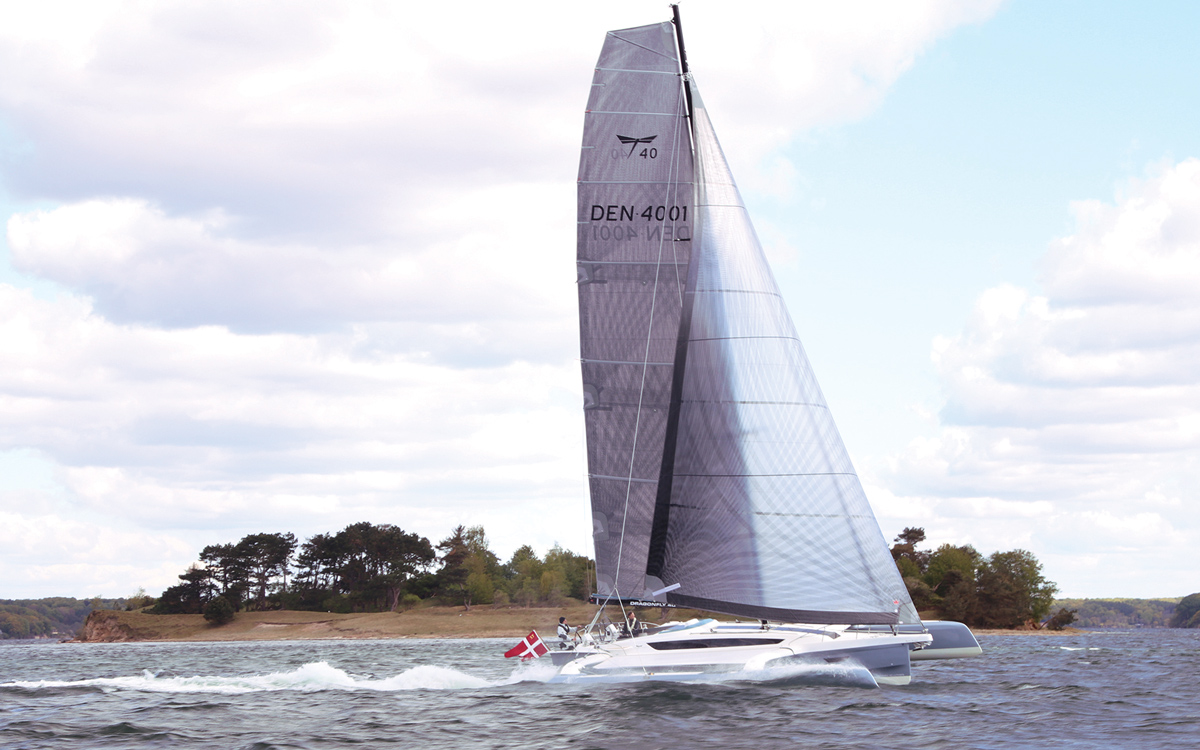
Mainsail handling: Advanced sailing techniques for catamarans and multihulls
A mainsail cannot know whether it is hoisted on a monohull, a catamaran or a trimaran. The principles of sail…

The best bluewater multihulls of all time: a complete guide
What are the best bluewater multihulls for long term cruising? The one you own, or the one you can afford…
Learning a performance catamaran’s sensitivity to weight can be a real learning curve. Compared to cruising catamarans, performance cats tend to be half the weight (or even less). Meanwhile, compared to a monohull the main difference is in the areas where the weight is most concentrated. A monohull’s weight is predominantly in its keel. Almost the entire weight of the boat is concentrated in around 15% of the boat’s length. Conversely, a multihull has no keel, so without that pendulum effect its centre of gravity is higher and less stable. On a multihull the weight is distributed along almost 90% of its length.
In practice, this means that what you carry, both below and above decks, has a big impact on the boat’s performance and safety. The first step is to become minimalists. Summon your inner Marie Kondo and ask yourself “Does this bring me joy? Does this keep me safe?” of every single item that moves from dock to boat. If it doesn’t – don’t take it.

Performance cats are weight sensitive so streamline your possessions onboard. Photo: Carl Newton
Step two is to arrange your belongings evenly around the boat. Ensure you don’t list the boat to port or starboard. Try to keep weight amidships and ideally low down. Avoid loading up the bow lazarettes or aft areas with too much weight.
When sailing, don’t forget that the worst kind place for weight is aloft. Without the keel, you significantly reduce the stability of the boat by having a furled Code 0 (for example) hanging around up the rig. It’s inconvenient to drop it every time, but it’s worth it.
Higher speeds, bigger loads, a lighter boat and higher centre of gravity don’t sound like the safest characteristics, and they aren’t if poorly managed. But you can also use them to your advantage. Being able to sail faster means you sometimes have an option to run away from bad weather.
But there are other safety drills that are worth thinking about ahead of time. What is your MOB recovery plan? With cats’ high freeboard, some owners plan to reverse up to the casualty and pick them up from the steps at the back. But how many have practiced that? Will it involve dropping the mainsail? Could the props injure the casualty? How does the back of the boat behave in a significant sea state? I’d recommend practising this until you have a plan that works for you on your boat with the equipment you have. The same should be said for plans to evacuate the boat, or deal with a fire on board.
If you enjoyed this….
Yachting World is the world’s leading magazine for bluewater cruisers and offshore sailors. Every month we have inspirational adventures and practical features to help you realise your sailing dreams. Build your knowledge with a subscription delivered to your door. See our latest offers and save at least 30% off the cover price.

The global authority in superyachting
- NEWSLETTERS
- Yachts Home
- The Superyacht Directory
- Yacht Reports
- Brokerage News
- The largest yachts in the world
- The Register
- Yacht Advice
- Yacht Design
- 12m to 24m yachts
- Monaco Yacht Show
- Builder Directory
- Designer Directory
- Interior Design Directory
- Naval Architect Directory
- Yachts for sale home
- Motor yachts
- Sailing yachts
- Explorer yachts
- Classic yachts
- Sale Broker Directory
- Charter Home
- Yachts for Charter
- Charter Destinations
- Charter Broker Directory
- Destinations Home
- Mediterranean
- South Pacific
- Rest of the World
- Boat Life Home
- Owners' Experiences
- Conservation and Philanthropy
- Interiors Suppliers
- Owners' Club
- Captains' Club
- BOAT Showcase
- Boat Presents
- Events Home
- World Superyacht Awards
- Superyacht Design Festival
- Design and Innovation Awards
- Young Designer of the Year Award
- Artistry and Craft Awards
- Explorer Yachts Summit
- Ocean Talks
- The Ocean Awards
- BOAT Connect
- Between the bays
- Golf Invitational
- BOATPro Home
- Superyacht Insight
- Global Order Book
- Premium Content
- Product Features
- Testimonials
- Pricing Plan
- Tenders & Equipment

Bering Yachts introduces new 24m catamaran model BC80 with two configurations
Turkish shipyard Bering Yachts has announced a new 24-metre catamaran model known as BC80 at this year's Cannes Yachting Festival.
The yacht is the largest in its class at 24 metres and is joined by the 18.9-metre BC60 and the BC70, which measures 21.3 metres. Owners can choose between two layouts: the flybridge version and the solar-powered version.
The first has been billed as a "more classic yachting experience", featuring an expansive 82-square-metre flybridge and 1,000 square feet of solar panels which can generate over 20kW of energy on a sunny day. The yacht can then remain at anchor for extended periods without relying on generators.
Meanwhile, the solar-powered version is suited to "the environmentally conscious adventurer", with a massive solar panel array, high-capacity lithium-ion battery bank and a state-of-the-art "kick-saving" system. This system significantly reduces generator dependence and allows guests to enjoy silent cruising for up to 24 hours without running the generators.
The BC80's impressive interior volume is aided by an expansive 10.8-metre beam, giving guests the "ultimate three-decker experience" with a spacious main deck with 2.4 metres of headroom, a dedicated upper deck with flybridge option, and a comfortable lower deck. In terms of accommodation, owners can choose between four, five or six cabins with the option of a master suite on the main deck.
The standard layout features a galley positioned forward on the main deck, while all guest accommodations are located in the sponsons (hull extensions) for extra privacy and reduced noise.
Powered by a pair of Volvo Penta engines, the yacht will reach top speeds of 15 knots and a cruising speed of 10 knots.
This follows the news that the steel hull of its 39.5-metre B125 model had been transported from Istanbul to Antalya ahead of outfitting . Delivery is anticipated for September 2024.
Sign up to BOAT Briefing email
Latest news, brokerage headlines and yacht exclusives, every weekday
By signing up for BOAT newsletters, you agree to our Terms of Use and our Privacy Policy .
Similar yachts for sale
More stories, most popular, from our partners, sponsored listings.

IMAGES
VIDEO
COMMENTS
On average, cruising catamarans can reach top speeds of 15 knots, around 17.3 mph (27.84 kph). ... The Outremer 45 can reach about 15 knots, but the most comfortable sailing speed is 10 knots. However, it can travel up to 25 knots in the right wind conditions, ...
The Ice Cat 61 is a luxury catamaran. At 61 feet (18.60 meters) long, it is a large catamaran that has been designed with both speed and stability in mind. While its average cruising speed is 12 knots, it can achieve up to 25 knots. The ICE Cat 61 has been designed with carbon and glass fiber - materials that allow the boat to be lighter.
Daniel Wade. Catamarans are known for their speed, and some vessels are fast enough to break world sailing speed records. Catamarans can go between 15 and 30 knots, with the fastest achieving speeds well in excess of 60 knots. Sailing catamarans are sometimes twice as fast as monohulls and cut through the water with greater efficiency.
2) Cruising Catamarans. Another type of sailing catamaran is a cruising catamaran. These often come with complete living accommodations, so they sacrifice speed over their sportier counterparts. They can average between 9 and 10 knots, depending on the conditions. The top speed is typically around 15 knots.
The crew wrote a detailed report of the experience and the boat's performance. CONDOR exceeded 30 knots occasionally, but average speeds were between 14 and 17 knots. Their best 24 hours saw 328 nm (an average speed of 13.7 knots). The company motto says it all. "Life is too short to sail a slow boat.".
Speed sailing records are sanctioned, since 1972, by the World Sailing Speed Record Council ... Catamaran Techniques Avancées: Gérard Navarin FRA Stes-Maries (France) 42,12 78 48,47 1988: Windsurf: ... on 24 November 2012 they recorded a top speed of 68.33 knots in a 25-29-knot wind.
A winning balance, it turns out, with the Balance 482 securing its position as the Best Performance Cruiser for 2022. More: balance catamarans, Boat of the Year, Boat of the Year 2022, catamaran, Kinetic Catamarans, print 2022 jan, Sailboats, seawind catamarans. With a powerful, versatile sail plan—as well as light, solid construction and go ...
For five years, my wife and I enjoyed catamaran sailing on a Lagoon 380. We then switched—for many reasons—to a Cabo Rico 38. The Cabo Rico is a traditionally-designed monohull with a full keel and a heavy displacement. ... Catamaran Top Speed. As you can see, catamaran speeds vary from just slightly better than monohulls to extraordinary ...
A Code 0 can double or even triple the boat speed: in 6 knots of wind, an Outremer will sail at 2-3 knots with a jib, but 5-6 knots with a Code 0. It's a great sail and worth the investment, but ...
The goal is speed, performance and offshore comfort, both in the strong stuff and, more importantly, in whispering airs that park-up monohulls. "A good performance catamaran can sail 1.2 to 1.5 times faster than windspeed in some conditions, meaning less time motoring and more time sailing," says Greg Young, designer of the TAG 60.
The Outremer 4x is a stable and comfortable high-speeding cruising catamaran that performs ocean crossings and confronts any weather with remarkable ease. Named the European Boat of the Year in 2017, this 48-foot (14.6 m) bluewater cruiser sails faster than wind speed and attains maximum cruising speeds of 20 knots.. The 4x is an upgrade of the extremely popular Outremer 45, thus retaining ...
An F50 catamaran preparing for the Sail GP series recently even broke this barrier, reaching an incredible speed of 50.22 knots (57.8mph) purely powered by the wind. This was achieved in a wind of ...
Gunboat 62. gunboat_catamarans. An original performance catamaran cruiser from the iconic Gunboat manufacturer, the Gunboat 62 has truly cemented its place as one of the best catamaran sailboats to ever grace the oceans. Honestly speaking, this cat-inspired a whole range of other incredible boats including HH66 Catamaran and the Balance 526.
The boats that most people race are considered fast at nine knots; screaming at 15. That's about 10 to 17 m.p.h. Then came the F50 catamaran in 2019, with wings instead of sails and hydrofoils ...
This can only happen in case the boat can plane on the water's surface or be lifted on hydrofoils. For most boats, the longer the boat, the higher the maximum hull speed is. Sailing catamarans typically average about 10 knots while pontoon boats average about 16 knots.
Every morning before sailing, the catamarans are assembled and craned into the water. At the end of the day, the F50s are lifted back out of the water and disassembled for maintenance. ... As breathtaking as the current speeds of the F50 catamarans may be - the top speed in the 2022 season of SailGP was just under 100 kilometres per hour (km ...
The best catamarans for sailing around the world include: Lagoon 42. The Fountaine Pajot Ipanema 58. Manta 42. Catana 50. Dolphin 42. Gunboat 62. These cats focus on speed, safety, and comfort for longer journeys. This article will show you the seventeen best catamarans for long journeys, and why they're the best.
The 5 Best Sailing Catamarans. 1) Lagoon 42 sailing catamaran - From $365,000. 2) Leopard 45 best sailing catamaran - From $519,000. 3) Fountaine Pajot Astréa 42 catamaran - From $429,000. 4) Seawind 1600 catamaran - From $859,000. 5) Outremer 45 best sailing catamaran - From $757,000. Budget sailing catamarans for sale.
Top Speed: 9-10 knots under sail; Price: $600,000 ... Whether you're handling a sailing catamaran or a power catamaran, understanding how to control the vessel's dual engines, accounting for wind, and mastering differential thrust are key to a smooth ride and docking. With time and practice, you'll find that catamarans offer unparalleled ...
1 Sail at higher angles to build up apparent wind speed (AWS) and boat speed. 2 Soak downwind as the apparent wind angle (AWA) surges forward with the acceleration. 3 Drive the boat back slowly ...
Turkish shipyard Bering Yachts has announced a new 24-metre catamaran model known as BC80 at the 2024 Cannes Yachting Festival. ... the yacht will reach top speeds of 15 knots and a cruising speed of 10 knots. ... Content presented under the "BOAT Presents" logo is an advertising feature and Boat International Limited has been paid to include ...